KUBRICK'S LOLITA
A SHOT-BY-SHOT ANALYSIS
PART THREE

Go to TOC for this film ( (which has also a statement on purpose and manner of analysis and a disclaimer as to caveat emptor and my knowing anything authoritatively, which I do not, but I do try to not know earnestly, with some discretion, and considerable thought).
A NOTE ON THIS ANALYSIS. I COMPARE, SCENE BY SCENE, AT THE END OF EACH, KUBRICK'S FILM WITH NABOKOV'S SCREENPLAY. I HAVE ALSO UNDERLINED THAT DIALOGUE WHICH IS FROM THE NABOKOV SCREENPLAY BUT WHICH IS USUALLY PARAPHRASED. DIALOGUE IN THE FILM WHICH WAS IN THE BOOK, BUT NOT IN THE SCREENPLAY, MAY BE UNDERLINED BUT IS OFTEN INSTEAD OUTLINED IN THE COMPARISON SECTION OF EACH SCENE.
TOC and Supplemental Posts | Part 1 | Part 2 | Part 3 | Part 4 | Part 5 | Part 6 | Part 7 | Films Home
LINKS TO SECTIONS OF THE ANALYSIS ON THIS PAGE:
A Proposal, Shots 167 through 182
A Proposal, Comparing Nabokov with Kubrick
The Mexican Screen
Humbert and the Teddy Bear
The Bull and the Matador
The Tokyo Poster
The Drome Poster
A Rainy Day, Shots 183 through 244
A Rainy Day, Comparing Nabokov to Kubrick
Re-examining Shots 230 Through 237 and Linkage to The Shining
That Poodle the Car Swerves to Avoid and Hits Charlotte Instead
Taking a Second Look at the Haze House
Location of the Haze House
Circularity, Coincidence and 242
Forever
The Interruption
MA
The Column
The Postal Box
42Q
Always Darkest Before the Dawn, Shots 245 through 264
The Dawn, Comparing Nabokov to Kubrick
Kidneys and Eggs
Inundation
The Shadow Behind the Curtain
More on Nabokov's Doubling
Humbert was Perfectly Capable of Intercourse with Eve, but it was Lilith He Longed For
The Birth of Lolita and its Relationship to Lilith
Charlotte and Shelly Winters
167 LS from Humbert's 2nd floor window of the station wagon being packed by Louise in preparation to take Lolita to camp. (44::20)
168 MS Humbert in bed. (44::23)
Waking to the sound of the preparations below, Humbert gets up, slips on his robe and goes to the window.
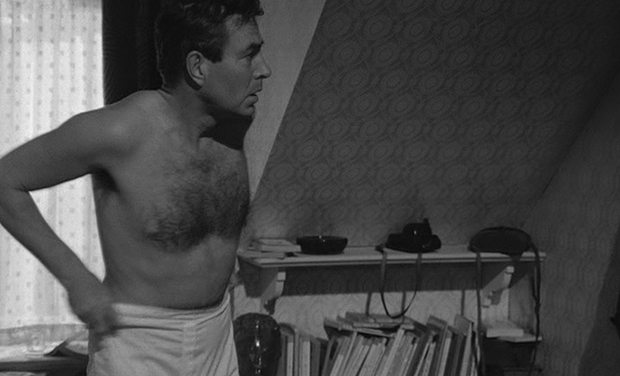
169 LS the station wagon, Lolita beside it looking up at Humbert's window, seeing him. (44::45)
170 MS Humbert before his window, looking down. (44:49)
171 LS Lolita looking up at the window. (44:51)
LOLITA: I'll be right back.
172 MS Humbert before his window, looking down. (44:54)
Shot 169 | Shot 170 |
 | 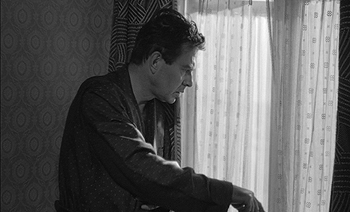 |
Shot 171 | Shot 172 |
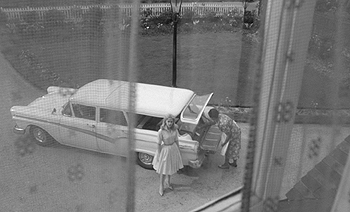 | 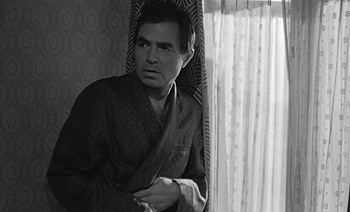 |
173 MLS Interior hall, Lolita running in the front door. (44:57)
The camera follows her up the stairs to where Humbert already stands, she running to him and embracing him.
174 MCU Lolita from behind Humbert's left shoulder. (45:03)
LOLITA: Well, I guess I won't be seeing you again, huh.
175 MCU Humbert from behind Lolita's right shoulder. (45:07)
HUMBERT: I shall be moving on. I must prepare for my work at Beardsley College in the fall.
176 MCU Lolita from Humbert's left shoulder. (45:14)
LOLITA: Then, I guess this is goodbye.
177 MCU Humbert from behind Lolita's right shoulder. (45:17)
The car honks twice.
HUMBERT: Yes.
178 CU Lolita. (45:21)
LOLITA (winking and smiling): Don't forget me.
Shot 173 | Shot 174 |
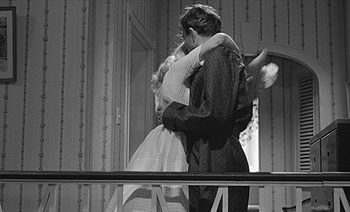 | 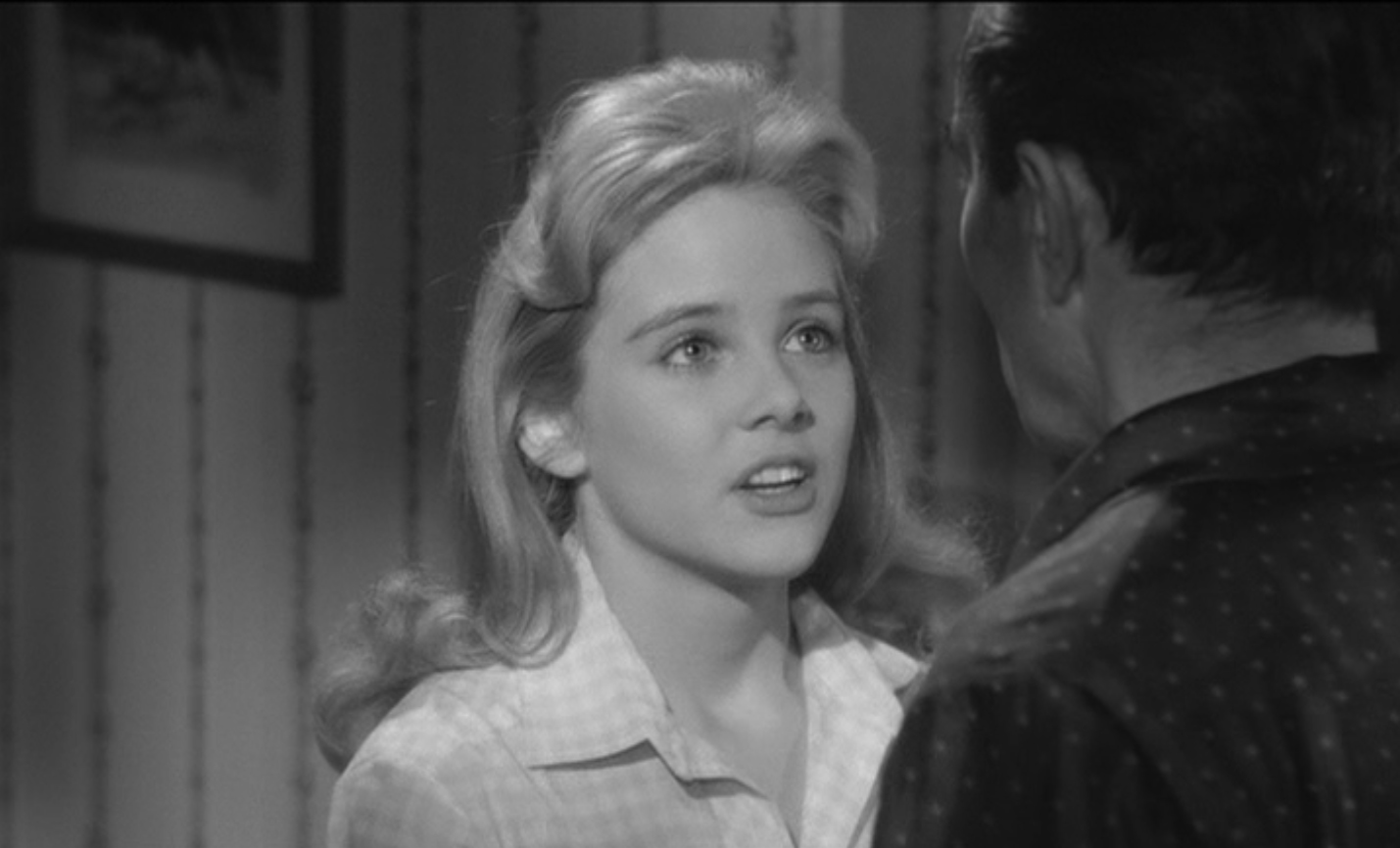 |
Shot 175 | Shot 176 |
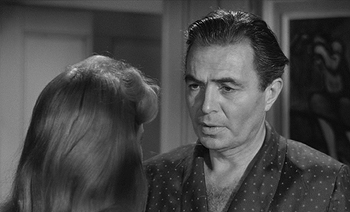 | 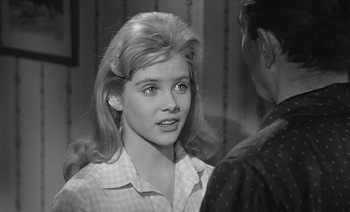 |
Shot 177 | Shot 178 |
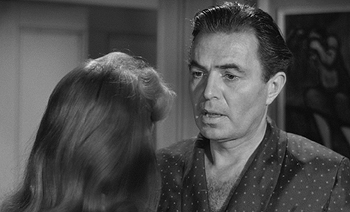 | 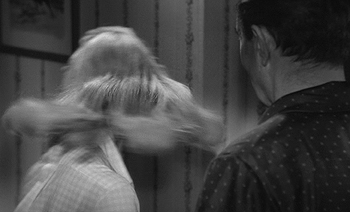 |
After the scenes of Lolita hand-holding with Humbert and baiting her mother, Kubrick gives us a scene of Lolita represented in fresh-faced, girlish innocence. There is no kiss, she simply runs up to give him a hug. She believes this is the last time to see Humbert and she's not torn up about it. She offers a teen's heartfelt but quickly-we-move-on-with-life goodbye. "Don't forget me!" She twirls, runs away, and you know that, at camp, she will not be missing Humbert.
179 MLS Lolita running from Humbert. (45:23)
He watches her run down the stairs, then he turns to go to his room and instead goes through the open door opposite into Lolita's room. He sits on her bed, then lies down with his face on her pillow.
180 LS of the front of the house as the car leaves, Louise waving. (46:15)
The car pulls out and goes down the street as 3 bicyclists approach on the sidewalk.
181 MLS Humbert on Lolita's bed. (46:25)
LOUISE (off screen): Are you upstairs Mr. Humbert? Mr. Humbert!
Shot 181 | Shot 182 |
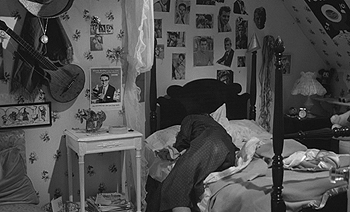 | 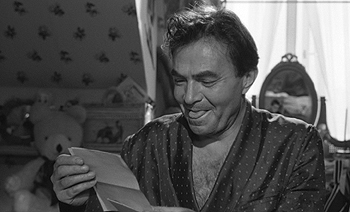 |
182 MCU Humbert seated on Lolita's bed. (46:39)
Humbert sitting up, Louise enters.
LOUISE (offering an envelope): Mrs. Haze asked me to give you this.
HUMBERT (taking it): Thank you very much.
Louise exits. Humbert opens the envelope and begins reading.
HUMBERT: This is a confession. I love you. Last Sunday in church, my dear one, when I asked the Lord what to do about it, I was told to act as I am acting now. You see, there is no alternative. I have loved you from the minute I saw you. I am a passionate (he laughs) and lonely woman, and you are the love of my life. Now you know. So you will please, at once, pack and leave. This is a landlady's order. I am dismissing a lodger. I am kicking you out. Go, scram, départez! I shall be back by dinnertime. I do not wish to find you in the house. You see, chérie, if you decided to stay, if I found you at home, which I know I won't, and that's why I'm able to go on like this, the fact of your remaining would only mean one thing (he laughs) that you want me as much as I do you (laughs) as a lifelong mate, and you are ready to link up your life with mine forever and ever, and be a father to my little girl. Goodbye, dear one. Pray for me, if you ever pray.
Humbert collapses on the bed in laughter and the camera pans over to the poster of Quilty on Lolita's wall.
This scene is in the screenplay with a few differences. Lolita runs upstairs to Humbert where no words are seemingly exchanged. She flies to him to kiss him, in all innocence, but Humbert evades her lips and gives her a practical peck on the forehead. When Charlotte and Lolita have left, he steps briefly into her room where he sees the Drome advertisement (the ad line is given in the screenplay, the image not described) then returns to his room to pack, where Louise finds him and gives him the note. Nabokov applies no religious sentiments to Charlotte.
In the book, there are again no words exchanged when Lolita runs upstairs, but this time Humbert and Lolita are given as kissing. Afterwards, Humbert takes solace lying on the clothes in Lolita's closet. Louise calls him from the stairs and gives Humbert the confessional.
In the book, Nabokov does have Charlotte having asked God, in church, what she should do and acting as she had been told to do. The letter goes on at some length and after Louise leaves Humbert climbs into Lo's bed to read it again.
I get such a huge, silly kick out of some of these details.
Remember the Mexican screen, the individual with the sombrero, leaning in a doorway, that was in the hall when Humbert first arrived?
Charlotte said she had told Lolita to keep it in her room and one would expect Kubrick might then show it in her room. We don't see it. Or do we?
Indeed we do, just not in the form we had expected. The individual in the sombrero is in the picture beneath the stringed instrument hanging on the wall. I wish we could get a closer look at the picture in which he's now residing.
Also, a representation of the individual in the sombrero also hangs on the wall in the form of the poncho and the sombrero, directly above the small image of the man in the sombrero.
I have the feeling that the difference in size representations of the individual in the sombrero should refer us back to Orson Welles' filmed contribution fo Himberama (see this post) and the different sizes in the cards there. When the cards are thrown from film to the stage, they are somewhat oversized. Then when the cards are thrown from the stage "into" the film, they become huge, as he holds up the Jack of Spades, Welles states, "You know it's remarkable, but on the screen some objects enlarge quite unusually."
I feel there is linkage as well to shot 441 in Barry Lyndon, when we have a close-up of the Chevalier dropping a 4 of clubs from his sleeve down into his right hand beneath the table. It's the only close-up, not to mention an extreme close-up, we have of the playing cards throughout the film, and also concerns a flip. Though the card drops into this right hand, in shot 442 we are shown the Chevalier with his left hand off the table. A black servant stands to his right. In shot 442 he says, "Rien ne va plus", meaning in gaming "no more bets" or "the die has been cast". The die has been thrown. Just as the cards, an ace and four of spades, have been thrown, actually, in Killer's Kiss, the Jack of Spades shown by Davey's face when he is knocked to the floor. Caesar is said to have said it when he crossed the Rubicon starting a civil war. A point of no return.
When Charlotte first comments on the screen, and that Lolita should keep it in her room, Humbert had believed she was referring to the maid. Now, when we see this small representation in her room, the maid enters with the message from Lolita. Via the maid, Kubrick is linking the two images.
Since Nabokov pays attention to the meaning of names, and so too does Kubrick, or at least he seems to at times, so I will note that Humbert comes from a German personal name meaning Hun = giant or bear cub + berht = famous or bright. The name Humbert seems to be related to Hubert, as in St. Hubert who was the patron saint of hunters, mathematicians, opticians and metalworkers.
In another of his novels, Nabokov has a Hubert H. Hubert who, like Humbert, preys upon a child, Flora.
This name origin may be perhaps seen here in the teddy bear in Lolita's room.
Humbert is himself a hunter when he takes up the gun and considers killing Charlotte but decides that he can't. St. Hubert is said to have had, during a hunt, a vision wherein he saw a crucifix between the antlers of a stag. This vision reportedly brought about his belief that a hunter should only shoot an animal when a clean, quick, merciful kill was ensured, that one ought to only kill old stags past their breeding years, and kill an injured or sick animal before a healthy one. One was also not to kill a female with young.
The hunter aspect resonates with the Enchanted Hunters Hotel and the Enchanted Hunter play. In the next scene, when Humbert is observed towing Charlotte into the bedroom via her ribbons, she assumes the lines of the cross with her outstretched arms. Considering that Humbert will shortly be contemplating killing her, then decides not to do so, I reflect back on St. Hubert's vision of the crucifix and its influence on his rules for hunting. It is perhaps coincidental.
We've observed already a couple of matador and bull paintings on the stairway wall and second floor landing of Charlotte's home. Here we have a basket beside a stuffed toy bear and on the basket is a bull and matador scene again. I always count bull and matador imagery as being significant in Kubrick's films, referring to the maze and the Minotaur, due the preponderance of mazes in his films and Killer's Kiss having been done by Minotaur Productions. There's so much else going on here and I've already written so much on this elsewhere that I'll just let this go with pointing out the presence of the bull and matador.
If anyone knows the origin of the Tokyo poster on Lolita's wall, I'd love to hear about it. I'll be discussing this poster later in the film before Lolita lands in the hospital.
I think we should have a closer look at the Drome poster.
If you really pay attention to it, the Drome poster may leave you scratching your head as certain parts don't immediately (or ever) make sense. Which isn't right for an ad. People may occasionally talk about hidden subtext in ads, but they should foremost have a very clear surface story. This one kind of appears to but doesn't. We see Quilty before a typewriter, the cigarette box to the side, but he also appears to be simply surrounded by a floaty melange of disconnected objects.
First of all, the poster looks much like a collage of pasted pieces. Quilty's head doesn't fit with the body doesn't fit with the hand etc., not with lighting or size.
If you look carefully you can see how the the palm edge of the hand holding the cigarette has been clipped out with the collaging and that the transverse band design of the tie next to the palm has been drawn/painted in. This is certainly a collage.
One can make out the typewriter and its keys. But what about the lamp and how it relates to the dark area, part of which I've outlined in blue, between the typewriter and the lamp. I asked a few people what they thought they were seeing and those who thought they were able to make out what this dark area was believed we are seeing books behind the lamp. There may be a book on the left, but this appears to be also something around the lamp. If the bottom of the lamp was shaped like that, with cut-aways, then we would be able to see the bottom rear of the lamp through the front cut-away, but we don't. I can't begin to make out what is going on with the lamp and that the negative space between it and the typewriter.
The black of whatever is that negative space is fairly neatly lined up with the black typewriter keys, and the way the keys are positioned in the photo, and the manner in which Quilty's hand is positioned, forms what is like the bottom of a box shape.
The table upon which the portable typewriter rests also seems, by its angle, awkwardly out of kilter with the typewriter and Quilty's body. What some might assume to be the typewriter carriage return bar couldn't be, it is much too high and doesn't look like a normal carriage return bar. What is it?
Kubrick has a poster in The Shining that everyone was always debating whether it was a basketball player (or some such) seen from the rear or front.
It eventually occurred to me that Kubrick was employing something like the Spinning Dancer illusion, where you can see an image from both perspectives, so you have two ways of viewing it.
This occurs in the same section in which Danny sees the twins in the hall. All other times he has seen the twins, the girl on screen left has her hand/arm in a handclasp over that of the girl on the right. Below is how he views them in the mirror in the Boulder apartment bathroom.
The two images below are briefly viewed as Danny looks at the number of Room 237 after finding its doors locked. Again, the girl on screen left is the dominant one, her arm crossed over the other's.
The dominant girl reverses only when Danny is himself in the flowered hall and sees his final vision of them. Instead, the girl on the right consistently has her arm over that of the the girl on the left. Dominance has changed.
These shots have been staged so that they are, otherwise, almost exactly the same. The placement of the girls in the hall is the same, and even their skirts measure about the same distance from the walls. Their unlinked arms are almost but not quite exactly the same, positioned ever so slightly different, but the print of the wallpaper behind their figures and how it relates to their outlines is an exact match. Their hair, however, in this final vision, is different. The girl on the left, previously, has hair that is slightly frizzy at the ends, while the other girl's hair is curled. The situation is now reversed, the girl on the left has the hair that is curled at the ends, and the other girl's hair is not.
My take on the Drome poster, especially after listening to the perspectives of other individuals, is we have a Lolita version of what occurs with the poster on the door of the telephone room in The Shining, and the eye has several ways of trying to make out what is occurring in the picture because of the staged ambiguity and the different ways of perceiving dominance (what is before and what is behind).
An advertising poster should be explicit in what we see. Instead, with the Drome poster, we have one that doesn't read easily, and we have some seeming perspective anomalies.
In The Shining, the poster that offers alternate perspectives occurs in conjunction with Wendy in a jacket that shows what seems like a stereotypical Mexican in sombrero slumbering beside a cactus.
One of the things I've noted in my analysis on The Shining is that the cactus on the front of her jacket, on the bottom pocketes, is in the shape of a 4, and that it is pretty much the same as the cactus on the back, against which the sleeping form rests, but now the cactus is reversed. The sleeping form is the Mexican in the sombrero.
I would think, in The Shining, Kubrick had planned this conjunction of the poster with the image of the sleeping individual in the sombrero, which harkens back to this scene in Lolita in which we have the ambiguous Drome poster of Quilty next the character in the sombrero.
One of the individuals with whom I was discussing this, Brien Engel, cropped the image and when it was cropped I saw we then have in the shadows one of Quilty's alternate (put on) personalities appear.
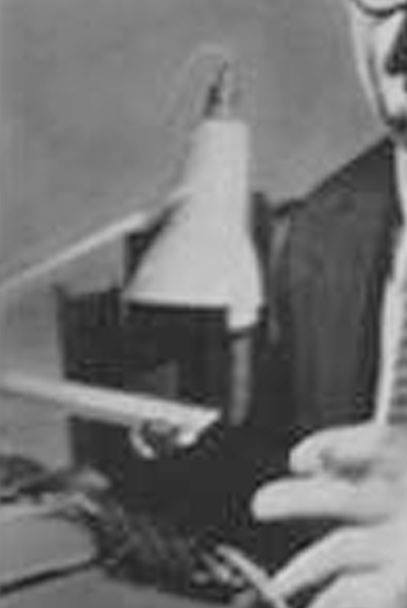
With that crop, the poster now shows Quilty as the psychologist who will visit Humbert at Beardsley.

Another individual with whom I was discussing this, Siri Southwick-Young, pointed out that to her the lamp looked like the Gemini spacecraft.
And what is Gemini but the twin. But this is some coincidental fun. Gemini wasn't christened such until Jan 3 1962, and was named Gemini because of the "double" idea, two men being in the pod. Lolita was filmed from November 1960 to February 1961 and released June 12 1962.
Anyway, there you go. The DROME poster, the focus of the camera at the end of this scene in which Humbert reads Charlotte's confession, is simply not quite right.
183 MLS Charlotte asleep in her bed. (48:50)
She reaches out for Humbert and finds his side of the bed empty. We can now see the Van Gogh she had pointed out when first showing Humbert her room. It is the painting on screen left and is, "Wheat Field with Cypress Trees", done in Saint Remy in June of 1889 while he was staying there at the Saint-Paul asylum.
CHARLOTTE: Hum! Hum! Hum, baby!
She has risen and slips on her shoes, as thunder sounds.
The sound of rain. It is incessant and so heavy as to sound like water pouring in the bathtub.
184 MS Humbert writing in his journal at his desk. (49:15)
HUMBERT (voice over): The wedding was a quiet affair, and when called upon to enjoy my promotion from lodger to lover, did I experience only bitterness and distaste?
He leaves his room and we have the brief black of the dividing wall.
HUMBERT (voice-over): No. Mr. Humbert confesses to a certain...
He takes refuge in the bathroom, locking himself in there.
185 LS from within the bathroom, Humbert entering and locking the door. (49:32)
HUMBERT (voice-over) ...titillation of his vanity, to some faint tenderness, even to a pattern of remourse...
186 LS Charlotte approaching the bathroom door and trying the lock. (49:38)
HUMBERT (voice-over): ...daintily running along the steel of his conspiratorial dagger.
CHARLOTTE: Dear, the door is locked.
HUMBERT (off screen): Uh-hmm.
187 MCU Charlotte. (49:45)
CHARLOTTE: Sweetheart, I don't want any secrets between us. It makes me feel insecure.
188 MS Humbert seated, writing. (49:54)
HUMBERT: Can't this wait until I come out of here?
189 MCU Charlotte. (49:58)
Thunder sounds as she thinks.
CHARLOTTE: I suppose.
She sits in a chair by the door.
190 MS Humbert seated, writing. (50:08)
CHARLOTTE (off screen): Hum, what do you do in there so long? I want to talk to you.
HUMBERT: I haven't been here long. In point of fact, I only just came in.
CHARLOTTE (off screen): Were there alot of women...
191 MCU Charlotte. (50:23)
CHARLOTTE: ...in your life before me?
HUMBERT (off screen): I've told you about them already.
CHARLOTTE: Well, you didn't tell me...about all of them.
192 MS Humbert seated, writing. (50:36)
HUMBERT: Charlotte, if it would make you any happier, I will sit write down and I will make out a complete list of every...
193 MCU Charlotte. (50:42)
HUMBERT (off screen): ...woman I have ever known. Would that satisfy you?
CHARLOTTE: Oooooh, I'm lonesome. I think it's healthy for me to be jealous. It means that I love you. You know how happy I can make you.
HUMBERT (off screen): Uuuuuum-huuuuum. Charlotte, I haven't even had my morning cup of coffee yet.
CHARLOTTE: You want me to make you some?
HUMBERT (off screen): Please, do that. Like a good little wife.
CHARLOTTE: All right.
She stands and exits left.
Shot 184 | Shot 185 |
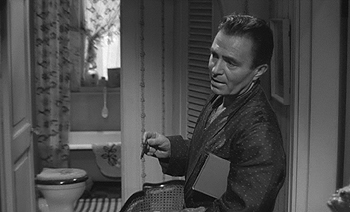 | 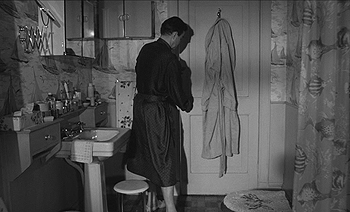 |
Shot 186 | Shot 187 |
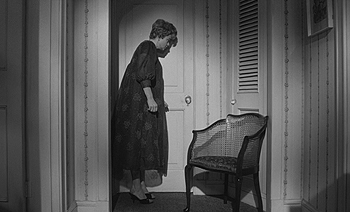 | 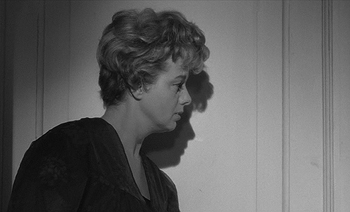 |
Shot 188 | Shot 189 |
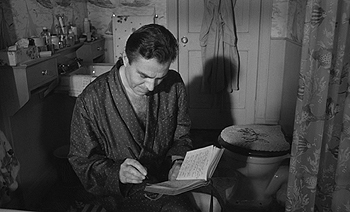 | 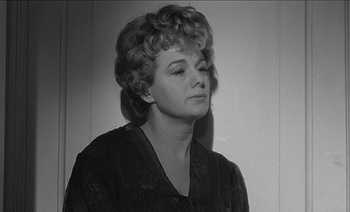 |
Shot 190 | Shot 191 |
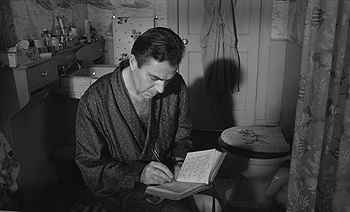 | 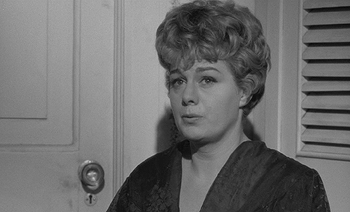 |
Shot 192 | Shot 193 |
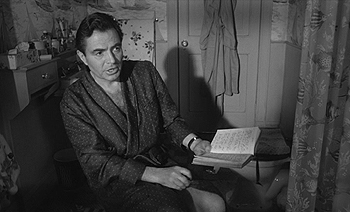 | 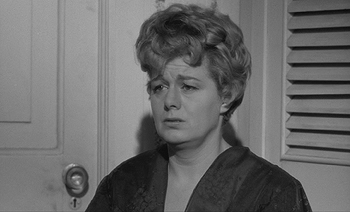 |
194 MLS Humbert unlocks the bathroom door and exits. (51:33)
195 MS From the hall, Humbert exiting the bathroom. (51:43)
As thunder sounds he enters his room, closes his door and goes to his desk to hide the journal.
196 MS Charlotte enters. (51:52)
CHARLOTTE: Darling!
197 MS Humbert at his desk with the journal in hand. (51:53)
He slips it into its drawer.
Shot 194 | Shot 195 |
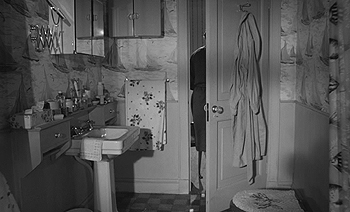 | 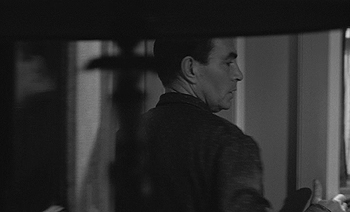 |
Shot 196 | Shot 197 |
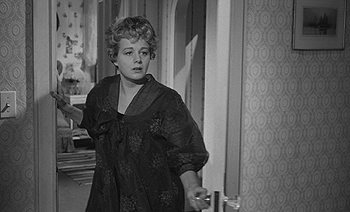 | 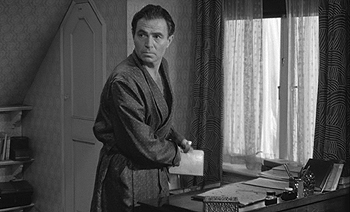 |
198 MS Charlotte at the door then walking toward Humbert. (51:54)
CHARLOTTE: I don't care about any other woman. I know that our love is sacred. The others were profane.
She hugs him.
HUMBERT: Yes, sacred, that's right. That's what it is. Hmmm.
He gently but firmly pushes her away and they exit his room.
CHARLOTTE: Oh, Hum.
CHARLOTTE (off screen): Hum, baby, you know I love the way you smell.
We've the briefest, less than an instant glimpse of light on the other side appearing on the left screen it seems it may actually be the door of Charlotte's room) that is washed away by the black.

199 MLS Charlotte and Humbert entering their bedroom. (52:09)
This is a wonderful cut from shot 198 to 199 where we have a couple of seconds of black between and over which Charlotte's voice continues as she says, "Hum, baby, you know I love the way you smell.." And though we have this phrase that links their exiting Humbert's room and entering Charlotte's...what happened to the time traversing the hall between? It has been eliminated.
We are returned to shot 73, when Charlotte was showing Humbert about the house, and after showing him his room and the bath she had told him he must see the collection of reproductions in her room and had led him there, the camera crossing the black of the partition between the hall and the bedroom, sliding along behind the closet, as it does here. But in this scene the hall, as we can see, has been dispensed with.
Kubrick's first use of this style of shot is in The Killing, shot 45, as we follow Johnny Clay through Marvin's apartment, from the kitchen through middle rooms to the front room, the camera traveling with him and passing behind the partition walls.
Another shot like this is in The Shining, when Stuart is showing Jack and Wendy outside the hotel. As they progress from the maze toward the hotel in shot 110, Wendy asks when the Overlook was built. Stuart begins to respond in shot 110 and then finishes his response in shot 111, telling her it was begun in 1907 and ended in 1909. Between shot 110 and 111, however, the group has advanced a number of yards across the parking lot to the garage, this physical portion of the journey omitted.
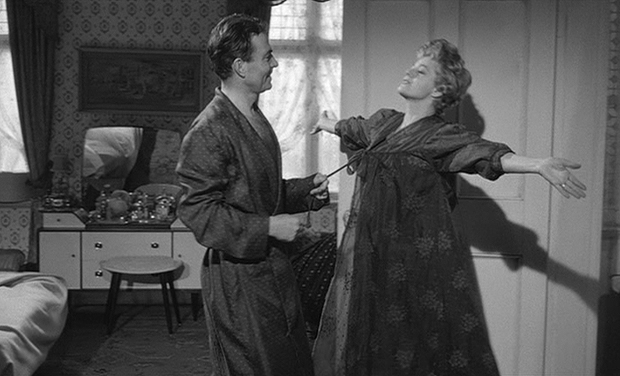
CHARLOTTE: Oh, you do arouse the pagan in me!
They sit on the bed, he picking up a bottle of alcohol.
CHARLOTTE: You just touch me, and I go as limp as a noodle. It scares me.
HUMBERT: Yes, I know the feeling.
He takes a swig.
CHARLOTTE: Do you believe in God?
HUMBERT (recapping the bottle): The question is, does God believe in me?
CHARLOTTE: Shhh!!!
Charlotte rises and goes to the dresser under her first husband's portrait.
200 MCU Charlotte. (52:37)
CHARLOTTE: I wouldn't care if your maternal grandfather turned out to be a Turk, but if I ever found out that you didn't believe in God, I think I would commit suicide.
She has taken a gun from the top dresser drawer.
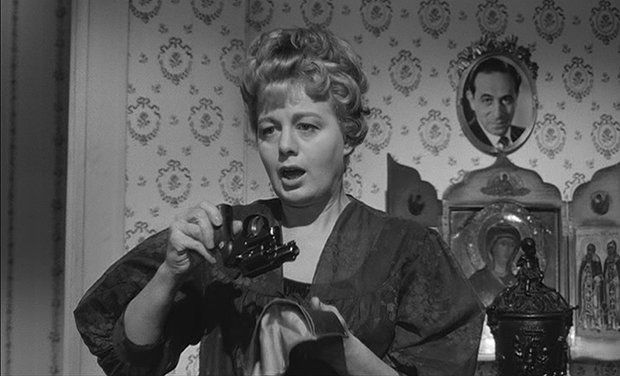
201 MS Humbert. (52:52)
HUMBERT: Hey! A gun!
202 MCU Charlotte. (52:55)
A peal of thunder.
CHARLOTTE: It belonged to Mr. Haze.
HUMBERT (off screen): You should be careful with those things.
CHARLOTTE: It's not loaded.
203 MS Humbert reclined on the bed. (53:02)
HUMBERT: That's what they all say. I didn't know it was loaded.
204 MCU Charlotte. (52:55)
CHARLOTTE: This is a sacred weapon. (Advancing.) It's a tragic treasure.
Shot 201 | Shot 202 |
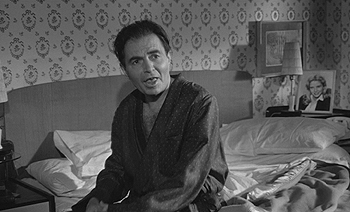 | 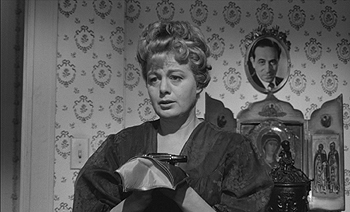 |
Shot 203 | Shot 204 |
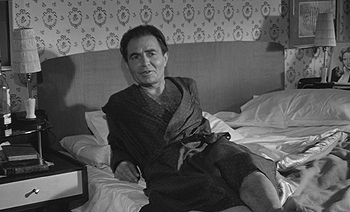 |  |
205 CU Humbert reclined on the bed. (53:10)
CHARLOTTE: Mr. Haze purchased it when he found out he was ill. He wanted to spare me the sight of his suffering. Happily, or unhappily, he was hospitalized before he could use it.
HUMBERT: You put it down, please.
She places it on the bedside table.
HUMBERT: Thank you. That's better now, isn't it. Huh?
He kisses her.
206 CU Humbert, kissing Charlotte, rolling her over, looking at portrait of Lolita. (53:35)
207 CU Charlotte, Humbert embracing her, Lolita's portrait in the background. (53:38)
CHARLOTTE: Oh, oh, you man. Oh, darling, you know, I have a most ambitious fantasy.
208 CU Humbert. (53:51)
HUMBERT: What's yours?
209 CU Charlotte. (53:55)
CHARLOTTE: I would love to get hold of a real French servant girl. You know, like the German girls the Farlows had? And have her come and live in the house.
210 CU Humbert. (54:09)
HUMBERT: No room.
211 CU Charlotte. (54:10)
CHARLOTTE: We could put her in Lo's room. I've been meaning to make a guest room out of that hole anyway.
212 CU Humbert. (54:18)
HUMBERT: And where, pray, will you put your daughter, when you get your guest...
213 CU Charlotte. (54:24)
HUMBERT: ...or your maid?
CHARLOTTE: You know, I've decided to send her straight from camp to a good boarding school.
214 CU Humbert. (54:32)
CHARLOTTE: You know, with strict religious training. And then on to college. Hum, darling, it's going to be you and me, alone, forever.
Shot 205 | Shot 206 |
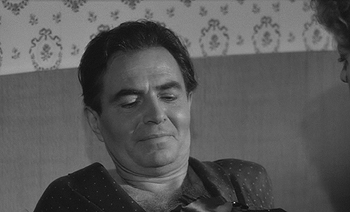 | 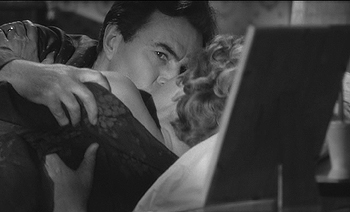 |
Shot 207 | Shot 208 |
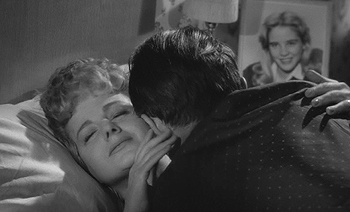 | 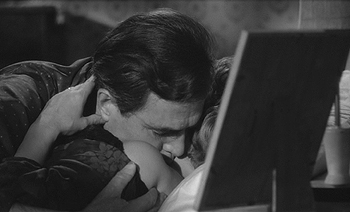 |
Shot 209 | Shot 210 |
 | 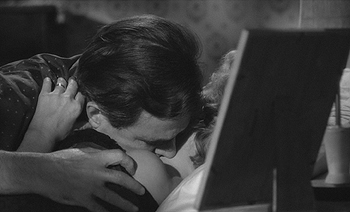 |
Shot 211 | Shot 212 |
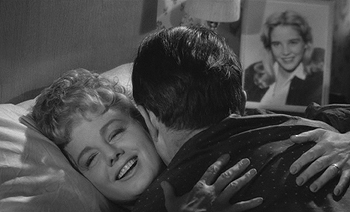 |  |
Shot 213 | Shot 214 |
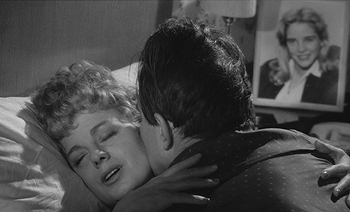 | 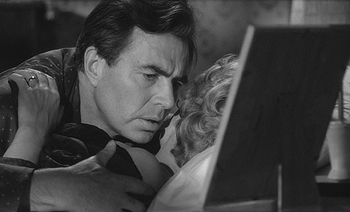 |
215 CU Charlotte. (54:46)
CHARLOTTE (whispers): Darling...you've gone away.
HUMBERT: Just a minute, I'm following a train of thought.
216 CU Humbert. (55:02)
Thunder.
Humbert rolls away from her.
217 MS Humbert facing the gun. (55:11)
CHARLOTTE: Oh, it doesn't matter. (She nips his shoulder.) C'est la vie. Hey, am I on that train?
HUMBERT: Yes.
CHARLOTTE: I should hope so.
The phone rings.
CHARLOTTE: Let's let it ring, huh?
The phone continuing to ring, she rolls over to answer it.
CHARLOTTE: Hello. Yes, this is Mrs. Charlotte Humbert. Oh, I'll accept the charges. It's Lolita, she's calling long distance. Hello? Hello, dear! We're fine. Yes, we spent the honeymoon on Hourglass Lake. Well, with a few other young marrieds. Is anything wrong? You lost your new sweater? In the woods? Yes, he's here. What do you want to thank him for? Candy. Just a minute. (She covers the mouthpiece.) Hum, I really wish you would not send her candy without consulting me. (Thunder.) Hum, I'm talking to you.
218 MCU Humbert sitting up. (56:44)
HUMBERT: Even in the most harmonious households, such as ours, not all decisions are taken by the female, especially when the male partner's fulfilled his obligations...
219 MCU Charlotte. (57:08)
HUMBERT (off screen): ...beyond the line of duty. When you wanted me to spend my afternoons sunbathing by the lake, I was glad to become the bronze glamour boy for your sake instead of remaining the scholar.
220 MCU Humbert. (57:18)
HUMBERT: Even then, I scoot along after you like an obliging little lap dog. Oh, yes, I'm happy, I'm delighted to be bossed by you, but...every game has its rules!
221 MS Charlotte from beyond Humbert. (57:28)
She throws down the phone on the bed, grabs up her robe and exits.
222 MLS Humbert in bed. (57:35)
HUMBERT (into the phone): Lolita!
Lolita has hung up. He bangs the phone down in its cradle, turns and grabs a drink from the bottle of alcohol. Slipping on his shoes, he looks at the gun and sees it's loaded.
223 MS Humbert, the gun in the foreground. (58:05)
224 CU of the loaded gun. (58:10)
225 MLS Humbert, staring down the loaded gun. (58:12)
Thunder.
He picks up the gun and checks it. The bullets fall out at his feet. He collects them. All 6 bullets.
226 MS Humbert, from beside the bedside table. We finally see the Monet print that Charlotte had spoken of when first showing Humbert the room, and it is "The Boardwalk on the Beach at Trouville". (58:39)
HUMBERT (voice over): No man can bring about the perfect murder. Chance, however, can do it. Just minutes ago she had said it wasn't loaded. What if I playfully pulled the trigger, then? She said it wasn't loaded. It belonged to the late Mr. Haze. She was having her morning tub. We had just finished talking about our plans for the future. I decided to play a practical joke and pretend I was a burglar. We were newlyweds and still did things like that to each other. As soon as it happened, I called an ambulance, but, it was too late. Simple, isn't it? The perfect murder.
He finishes reloading the gun. Thunder rolls.
Shot 215 | Shot 216 |
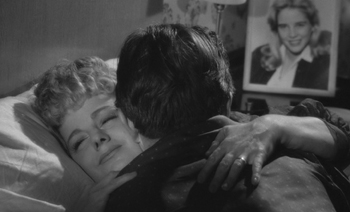 | 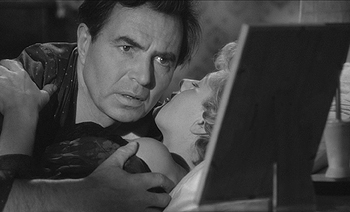 |
Shot 217 | Shot 218 |
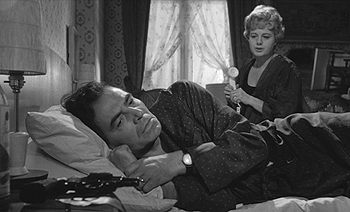 | 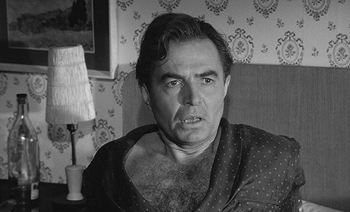 |
Shot 219 | Shot 220 |
 | 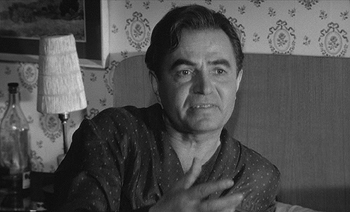 |
Shot 221 | Shot 222 |
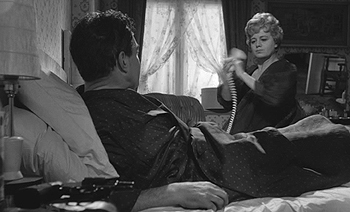 | 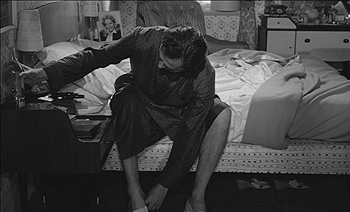 |
Shot 223 | Shot 224 |
 | 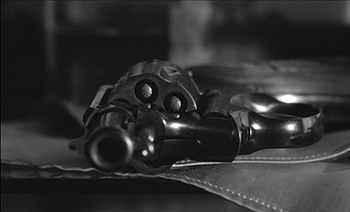 |
Shot 225 | Shot 226 |
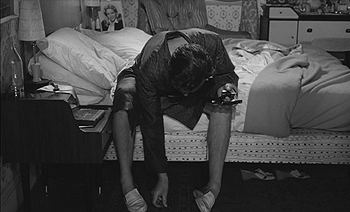 | 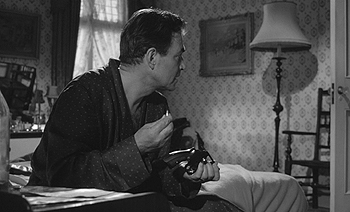 |
227 MLS Humbert rises. (59:27)
He exits the room.
Note how the urn is now unnaturally and dramatically dark, as is the icon of the Virgin and Child, while the wall behind the urn is brightly lit. The icon is the Virgin Hodegetria, She Who Knows the Way (of salvation).
Don't you just love how the glowering Howard Haze ever stares out at us from every angle? It occurs to me that there's every possibility he may have purchased that gun for use on Charlotte.
228 LS through the cracked bathroom door of the water running in the tub. (01:00:11)
When did the water in the tub begin running? We don't know as the rain outside has been heavy and unabating.
229 MS of Humbert looking toward the bathroom. (01:00:16)
HUMBERT: She splashed in the tub, a clumsy, trustful seal. And, oh, the logic of passion screamed in my ear. Now is the time. But, what do you know folks. I just couldn't make myself do it. The scream grew more and more remote, and I realized the melancholy fact that neither tomorrow nor Friday nor any other day or night could I make myself put her to death.
Humbert puts up the gun in his pocket, looks at his empty hands.
230 LS of bathroom through the cracked door. (01:01:01)
HUMBERT (off screen): Charlotte?
He pushes open the door revealing she's not there.
Shot 227 | Shot 228 |
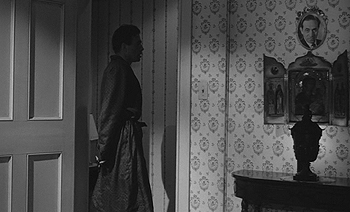 | 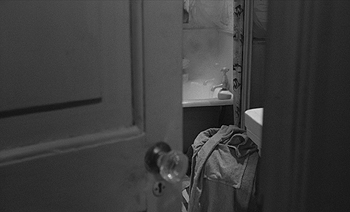 |
Shot 229 | Shot 230 |
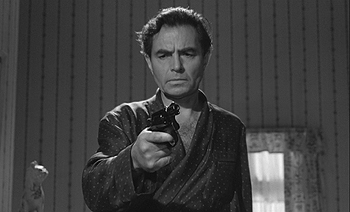 | 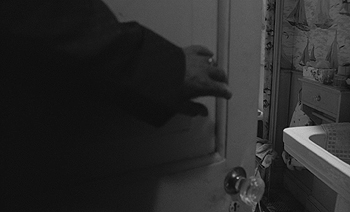 |
If the hand upon the bathroom door, opening it, reminds you of something else, it should. Shot 306 in The Shining.
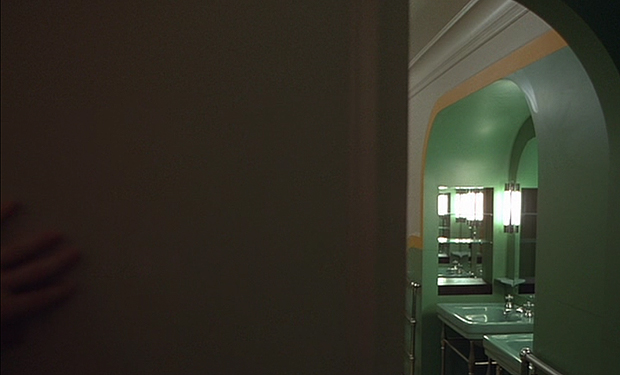
Just as Humbert's surprise might remind you of The Shining. Kubrick goes to a reaction shot of Humbert just as in The Shining he then went to a reaction shot of Jack at finding the woman in the tub, his expression changing from one of shock and fear to desire.
231 MS Humbert. (01:00:09)
Surprised, Humbert glances into Lolita's room.
HUMBERT (inaudibly): Darling?
He then crosses over to look in his room.
HUMBERT: Darling?
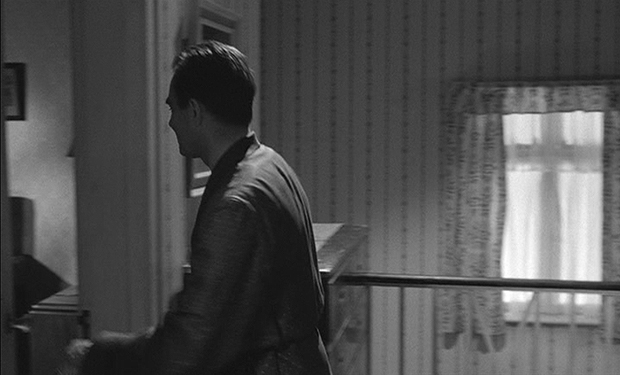
Note that with this section we have the first time we've seen the hall from this vantage point. We are shown it first in shot 185, as Humbert enters the bathroom, in a long shot. Then in shot 229 we have a closer view. Finally in shot 231 we have a very good view of it.
232 MCU Humbert entering his room. (01:01:19)
HUMBERT: Darling?
233 MS Charlotte at Humbert's desk reading his diary. (01:01:21)
234 MCU Humbert. (01:01:24)
HUMBERT: That's my diary. We don't read other people's diaries, do we?
Shot 232 | Shot 233 |
 | 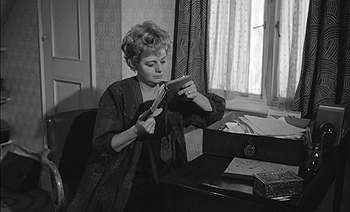 |
Shot 234 | Shot 235 |
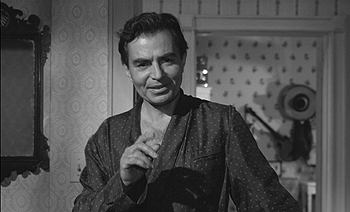 | 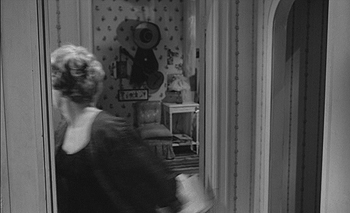 |
Shot 236 | |
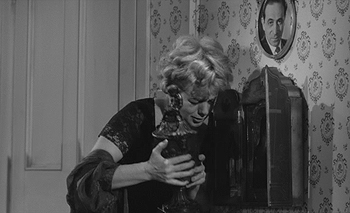 | |
235 MS Charlotte. (01:01:28)
HUMBERT (advancing into the frame): Charlotte, that's my diary. Give it to me, please.
Charlotte strikes him with the diary.
HUMBERT: Please, please, please. No, no, no!
CHARLOTTE: The Haze woman. The cow. The obnoxious mama. The brainless baba. Well, the stupid Haze is no longer your dupe.
HUMBERT: Give me that book, please. Give it to me. Please.
CHARLOTTE: Leave it alone or I'll scream out the window!
HUMBERT: Shhh. Now let's discuss this. Let's sit down and discuss it quietly like civilized people.
CHARLOTTE (throwing papers from his desk drawer at him): You're a monster. You're a disgusting, despicable, loathsome fraud.
HUMBERT: But I can explain.
CHARLOTTE: Get out of my way. Get out of my way.
HUMBERT: I want to talk to you.
CHARLOTTE: I want to get out of here. Go on. Get out of my way. I'm leaving here today. You can have all of it. (At the door.) But you are never going to see that miserable brat again!
Charlotte flees out the room.
HUMBERT (pursuing): Charlotte, please, listen to me!
236 MS Charlotte in her room, closing her door and locking it. (01:02:31)
HUMBERT (off screen): Charlotte! (Bangs on the door.) Charlotte, open the door. I want to speak to you. It's so easy to explain. It's a hallucination. You're crazy, Charlotte. I'll get you a drink. That's what you want, a nice little drink.
CHARLOTTE (speaking to Harold's photo): Harold, look what happened. I was disloyal to you. I couldn't help it, though. Seven years is a very long time. Why did you go and die on me?! I didn't know anything about life. I was very young. If you hadn't died, all this wouldn't have happened. (She throws aside the diary and embraces the urn.) Oh, darling, forgive me. Forgive me. You were the soul of integrity. How did we produce such a little beast? I promise, I promise, I promise you that I'll know better next time. Next time it's going to be someone you'll be very proud of.
Charlotte crumples to the floor crying. As she does so, the camera slides down as if going through the floor to the kitchen, shot 237.
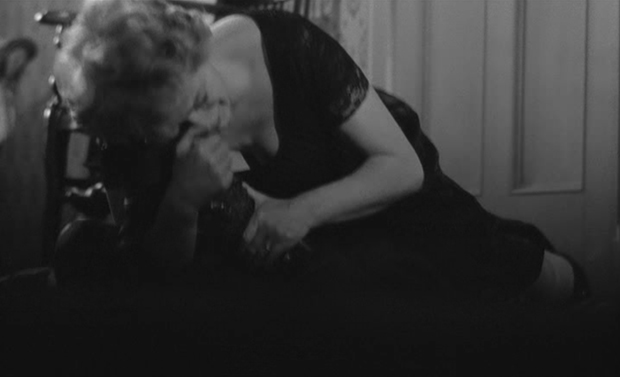

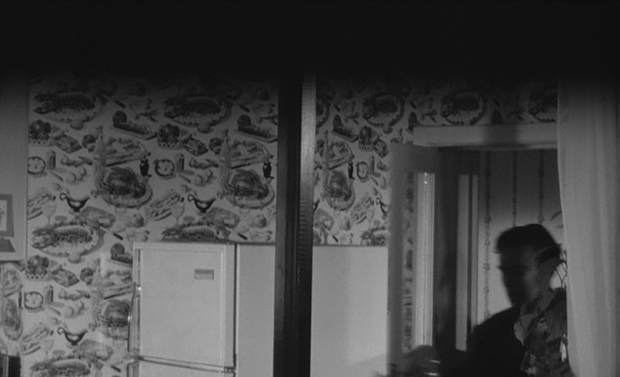
237 MS Humbert in the kitchen. (01:04:01)
He makes drinks for them, yelling up to her.
HUMBERT: Charlotte! Those notes you found are fragments of a novel I'm writing! Your name and Lolita's were put in by mere chance, just because they were handy. That's the way novelists work. They think of the names of their friends and the people who enter into their daily life, like, uh, like the Farlows, and they think up funny situations. I'm making a Martini for you.
The phone rings.
HUMBERT: Uh, Charlotte! I'll take it!
238 MS Humbert going to answer the phone. (1:05:05)
HUMBERT: Yes. Yes, this is he. Yes. What? But my wife is upstairs in her bedroom. Is this a gag? Is this one of the fellows at the country club? Yeah, just a minute. Charlotte? There's a man on the line who says that you've been (the door blows open) hit by a car. Now, listen, please, my friend. Just hold on, one moment.
239 LS of the front door, Humbert going to close it. (01:05:37)
Thunder crashes.
240 MCU Humbert looks out the window. (1:05:40) He hears sirens, opens the door and steps out.
241 LS of the gate. (1:05:46)
242 MCU of Humbert. (1:05:48)
He reaches in the door and, grabbing his coat, puts it on.
243 LS of the gate. (1:05:53)
Shot 237 | Shot 238 |
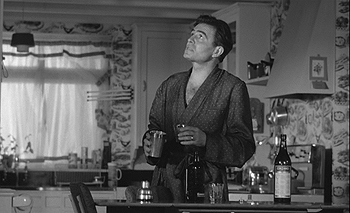 | 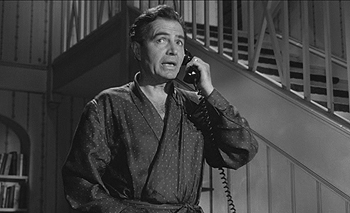 |
Shot 239 | Shot 240 |
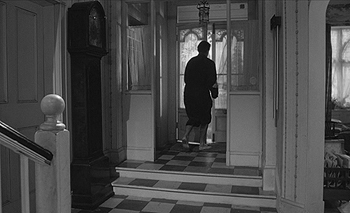 | 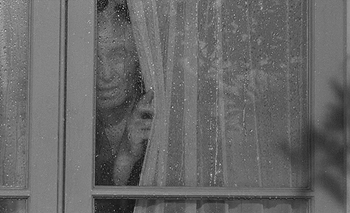 |
Shot 241 | Shot 242 |
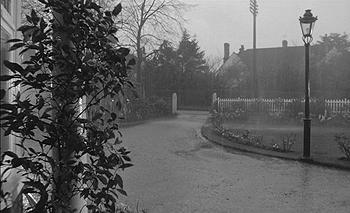 | 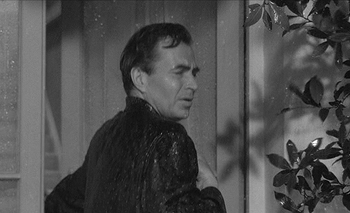 |
Shot 243 | |
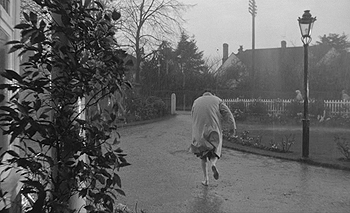 | |
244 LS of the accident scene. (1:06:03)
The camera is briefly on the car that has hit a white picket fence, then pans right to show Charlotte lying in the street, Humbert running toward the scene, passing the ambulance which has a license number of 42Q.
MAN (to older man seated): Take it easy, okay? (To Humbert.) Mr. Humbert, she just ran right in front of me. I swerved around, you see, to avoid hitting the dog and she just ran right in front of me. Look, my dad's in a state of shock, I've got to look after him, but I just wanted you to know it isn't my fault.
MEDIC: Are you the lady's husband?
HUMBERT: Uh, yes.
MEDIC: I'm afraid she's dead.
Charlotte is put on the stretcher. Crossfade to Humbert in the tub.
All of this is changed greatly from the screenplay, a number of scenes compressed into a single morning.
I have only underlined above dialogue that was in the screenplay, but there is a good deal that was taken also from the book and I will remark on this in a moment.
In the screenplay, after Humbert and Charlotte are married we find the couple in the kitchen eating breakfast. There is no scene in which Charlotte goes to find Humbert, he evades her by hiding in the bathroom, she follows him to his room where she sees him writing in his diary and declares their love sacred after pleading to learn of his past loves, not wanting secrets between them, then they go to the bedroom and she suddenly announces she will commit suicide with Harold's gun if she learns Humbert doesn't believe in God. None of this is there. Instead, Charlotte is showing Humbert her treasures and amongst them is the gun. She describes it as being a sacred treasure, but there is no talk of her having to commit suicide if she ever found out Humbert didn't believe in God. She doesn't ask him about his beliefs. There is no bedroom scene in which they begin to make love and are interrupted by a phone call from Lolita. Instead, the screenplay moves on to the lake, where Humbert has plotted to drown Charlotte. She tells him about her plans to get a maid and send Lolita off to boarding school. Humbert insists upon a too strenuous swim, during which she nearly drowns, as he'd hoped she would, but he saves her at the last moment. She tells him she had been alarmed by his eyes and worried he might not rescue her. When they arrive back home, he finds he forgot his sunglasses and returns to get them. When Humbert returns home, he finds Charlotte screaming over his diary, which she'd read in his absence. He goes to fix her a drink, planning how he will make the diary seem to be notes for a novel, and receives a call that his wife has been hit by a car. Nabokov has this depicted through a later police class on accident scenes in which a still photograph of Charlotte's death serves as example.
In the book, after their marriage, Charlotte is, however, mentioned as querying Humbert on his religious beliefs, and he replies that he believes in a cosmic spirit. "I countered by inquiring whether she would still want to marry me if my father's maternal grandfather had been, say, a Turk. She said it did not matter a bit, but that, if she ever found out I did not believe in Our Christian God, she would commit suicide. She said it so solemnly that it gave me the creeps."
Humbert also experiences some pleasure in the marriage, which Kubrick retrieved from the book and was not mentioned in the screenplay. "When called upon to enjoy my promotion from lodger to lover, did I experience only bitterness and distaste? No. Mr. Humbert confesses to a certain titillation of his vanity, to some faint tenderness, even to a pattern of remorse daintily running along the steel of his conspiratorial dagger."
The candy scene makes a brief appearance in the book in the form of a letter from Lolita, and Charlotte only mentions that she wishes Humbert wouldn't send candy without consulting her. They do not fight about it.
After the candy letter, in the book, Humbert and Charlotte go swimming at Hourglass lake where she speaks of wanting the maid and sending Lolita to boarding school for sound religious training. Considering that "No man can bring about the perfect murder; chance, however can do it", Humbert planned the drowning. It is here where Humbert silently follows a "train of thought" and Charlotte hopes she is on that train. There is no tub scene, Charlotte doesn't splash in the bath like a seal, instead it is in the lake. "She swam beside me, a trustful and clumsy seal, and all the logic of passion screamed in my ear: Now is the time! And, folks, I just couldn't...I realized the melancholy fact that neither tomorrow, nor Friday" etc. And a good thing, too, because when they're back on the bank, who comes up but Jean Farlow who had been watching them and almost put them into a painting of the lake she was doing.
When they do have an argument is after this, when, eating breakfast. Charlotte announces she is planning on them going to England for a vacation. That's when Humbert retaliates with, "Even in the most harmonious of households..." and Charlotte absolutely crumbles, even falling on her knees as she begs forgiveness.
Subsequent this, Humbert reading in his writer's study, Charlotte enters to discuss if there is anything wrong between them, and inquires why his desk is always locked. He says it holds love letters. Then, one day he's out getting sedatives for his insomnia (which he plans on using on Lolita one opportune day) and on his return home he finds Charlotte with his diary. She declares, as in the screenplay, she's leaving. He goes to fix her a drink. "Let us be civilized people. It is all your hallucination. You are crazy, Charlotte. The notes you found were fragments of a novel. Your name and hers were put in by mere chance..." Charlotte is writing a letter as Humbert tells her this, going from the kitchen to the bedroom once. Humbert returned to the kitchen and after this we have the death scene. Charlotte had been hit running out to mail the letter she was writing. The letter, lying beside her in the street, was instead given to Humbert.
See this separate post How Shot 306 in The Shining Duplicates Shot 230 in Lolita, and How Shot 237 in Lolita, Intimately Connected with Charlotte's Death and room 237 in The Shining, is (Perhaps) Connected with Hitchcock's Psycho?
At the end of The Killing, Johnny's loot-filled luggage atop a cart trundling to the plane, a poodle leaps out of its owner's arms and runs onto the tarmac, causing the cart to swerve to avoid hitting it. Johnny's luggage falls to the ground, opens, and the loot flies everywhere. We have much the same here.
I have rewritten this section and placed it in a separate post, The Deceptive Layout of the Haze and Beardsley Households in Lolita, How the Deception Occurs, and When We are Awakened to the Deception. I have left out a few paragraphs from this section in that rewrite, which combines also with a look at the Beardsley residence, so am leaving this section in place.
Now, I'm going to step back and take you through some shots from when Lolita left for camp.
Lo in the front drive | Lo runs in |
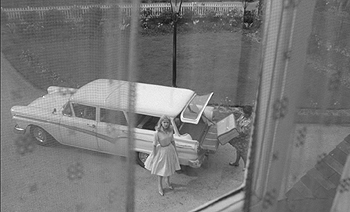 | 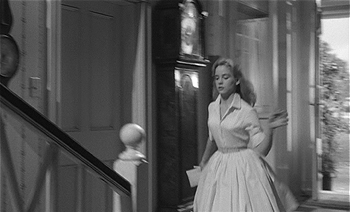 |
Lo runs up the steps | Humbert stares after her |
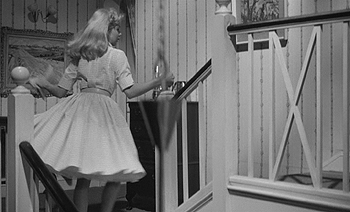 | 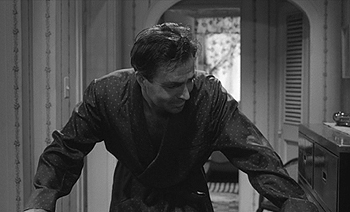 |
Humbert starts to go into his room | Humbert goes into Lo's room opposite |
 |  |
So, we had been given a good view of the front lawn from Humbert's window. Had seen Lolita run in through the open front door, through which we can see the driveway and the white slats of the fence beyond. When Lolita leaves Humbert, he looks after her as she exits, begins to go to his room, and then changes his direction and instead goes into Lolita's room. We are then, in shot 180, shown the front of the house for the second time in the film.
Here is how we viewed the house when Humbert arrived, shot 71.
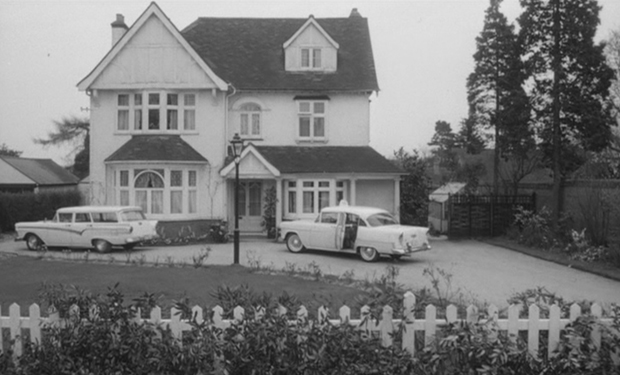
Below is approximately more how the house is, as we shall soon see, and it's doubtful there is a third floor as Humbert's room, though on the second floor, is the dormer shape of the third floor. As a matter of fact, so is Lolita's room a dormer.
The below may help in envisioning the second floor.
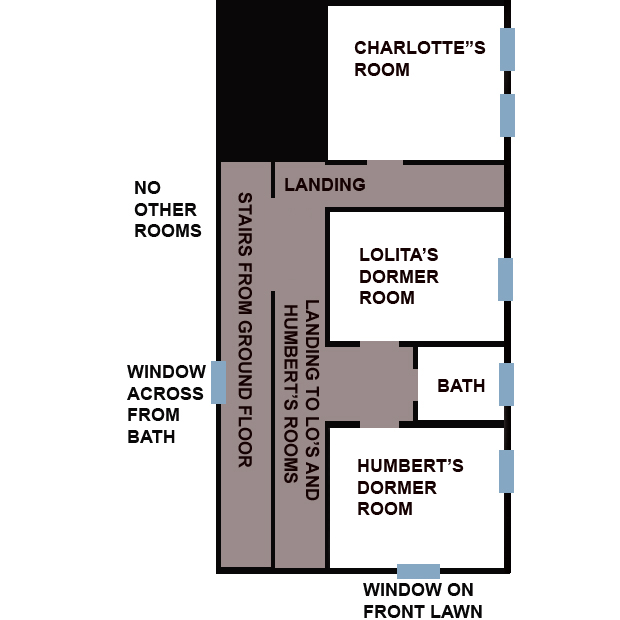
Kubrick, in this section, has Humbert mirroring his earlier right then left movements. After Humbert looks in the bathroom and finds Charlotte isn't there, he does the same first to the screen right room then the screen left room, though it's backward this time around as we're facing away from the bathroom rather than facing toward it.
As I was saying earlier, Kubrick only now has shown this vantage so we clearly see the second floor area beyond the stairs and that there is a window there. If the second floor extended all the way across the ground floor, as shown in the exterior shots, there would be another room where that window opposite the bathroom is.
We had been previously provided a glimpse of this in shot 185, when Humbert hid in the bathroom from Charlotte. In shot 229, he pointing the gun at the viewer (the bathroom door) we have a nice long view of that window finally. But here in shot 231 we have Humbert out on the landing and we've an even better idea of how that's all that's there, the window. There is no other half to the second floor.
Humbert starts to go into Lo's room | Humbert goes into his room opposite |
 |  |
It is only after Lolita has left the household that we are permitted this realization.
Of interest is how Kubrick is very faithful to certain details of the house matching the exterior while others are not.
He has already shown us, in shot 71, how the dining room off the living room area is not there in the exterior view, for the dining room does not open from the rear of the living room into the rear of the house. Instead, as you can see below, the dining room is off the side of the living room, not to the rear of it, and the patio to the garden in which we see Lolita is also to the side of the house.
However, the living room window is faithful to the one we see exterior, except that when we are inside we see see a circle rather than the arch that we view on the outside.
The camera subtly guides us into feeling that the dining room extends to the rear of the living room, especially with our expectation that the garden is to the rear of the house, following shot and our having observed that there is little lawn space to either side of the house,
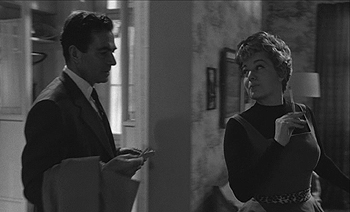 |  |
 |  |
 |  |
Why pay attention to these differences? Because Kubrick is so faithful to some details, and because Kubrick so deliberately reveals to us what is impossible, such as with his eventual pointed display to us of the peculiar window opposite the bathroom.
That window, before which Humbert hesitates and reverses course at least two times, functions rather as the window in Stuart's office in The Shining, which we see and realize that it is an impossible window as we have seen how the building extends beyond it, the lobby connecting to halls behind Stuart's office.
A difference with The Shining is that nothing is as it appears to be, almost nothing about the interior of the hotel matching up with its exterior. But, here, Kubrick is faithful to at least the living room and the entry hall, and Humbert's room, with the exception that it has the dormer shape that would fit with the third floor room though it is on the second floor.
Other similarities are had with The Shining. Room 237 in The Shining is where we have the peculiar scene with Jack and the several perspectives of the woman. First he is with a young woman then looks up and sees in the mirror the decaying, old woman that he is holding. Here, instead, Humbert is clasping Charlotte to him, looking at the photo of Lolita, imagining her with him instead of Charlotte, then when Charlotte tells him she's sending Lolita away and will turn her room into a maid's room, Humbert is faced with the prospect of being alone with Charlotte and turns away to contemplate the situation.
In The Shining, we see the drowned woman rising out of the bath, Kubrick leaving us to wonder whether she is there (even as a ghost) or a hallucination or if any of this has happened at all. Here, it's shot 230 where Humbert opens the door to the bathroom, a shot that will be recalled in The Shining, and he sees that though the water is running Charlotte isn't in the bath. There is indeed going to be a dead woman but she will instead be lying out in the rain in the street.
In the book and screenplay, recall, Humbert had planned to drown Charlotte, she had nearly drowned, and then he had saved her. By having Charlotte face down in the rain-drenched street, then, with the crossfade, briefly floating in Humbert's tub, Kubrick has Charlotte fated to a watery death.
All the scenes in which Kubrick moves the camera behind the wall partitions, as he follows the subjects from room to room, I have counted as a single shot, until we get to shot 198. As they leave Humbert's room, there is a brief flash of light on the other side of the partition followed by solid black and the hallway being skipped. So, I count their entering Charlotte's room as another shot, being 199. Then I do the same with the transition through the floor that occurs when Charlotte sinks to the ground in shot 236. As we then move to the kitchen I move my count on to shot 237. This is simply my gut instinct that 198 and 199 are to be counted as two separate shots, and that 236 and 237 are to be counted as two separate shots. Also, before approaching Lolita, I had analysed Killer's Kiss and The Killing, which also have some peculiar shots that appear to be one but are actually two, and I am partly basing my decisions here on what I learned from those shots. As it turns out, with the way I've counted, we have Charlotte dying during shot 237, while Humbert is in the kitchen, and that seems appropriate because we have this torrential downpour and when Humbert reaches her she's lying in a veritable pool of rain, which fits very well with the drowned woman appearing in room 237 in The Shining. We also have a very important alignment of ideas in shot 411 that signal I was correct in counting shots as I have.
Below is the real Haze household, Highburgh House on Packhorse Road in England.

The interior is nothing at all like the studio set. For instance, passing through an entry area, one passes doors to the front rooms and the stairway to the second floor is on the left running parallel the street, the second floor hall also running parallel the street.
The foliage in the area is so grown up over the years and different that it's difficult to tell where Charlotte might have met her demise, but my assumption is it would likely have been on a studio set. The action is plotted however so that it would seem to have occurred on North Park Road that intersects Packhorse Road just a couple of houses down. A 2008 Google view shows that area with a good deal of foliage that is absent in 2017.
What we see with the real house is the timber frame Tudor style that will also be observed at the Enchanted Hunters Hotel, both places bearing the number 242, it being the address of the Haze household and the room in which Humbert and Lolita stayed at the hotel. I would wonder if the dark timbers were painted white for the movie. If the house was already white, or if the timbers were painted white for the film, either way it would seem that the Tudor styling was intended to be suppressed and barely evident, yet a link to the Enchanted Hunters Hotel.
Kubrick's choice of the house number was 242, in which we see his penchant for circularity. Nabokov had it as 342 instead, and had made much of the coincidence of 342 being also the room Lolita and Humbert stay in at the Enchanted Hunters Hotel. Also, in the book, when Humbert receives the letter from Lolita asking for assistance, he reads it in an exam room that is numbered 342. Nabokov points out these coincidences in the novel, having the characters make note of them. Kubrick doesn't have the characters speak of them but expresses them in other ways. For example, we have the dim to mid scene with the Edgar Allen Poe poem, Humbert pointing out how Poe turns dim and it returns as mid, a circularity expressed in 242.
Humbert is as discomfited at the idea of staying alone with Charlotte forever as Danny will be with the prospect of playing forever and ever with the girl(s) at the Overlook in The Shining, and as Alice will be at considering the prospect of she and Bill having their eyes open forever in Eyes Wide Shut.
In the wonderful and repugnant scene where Humbert reads Charlotte's passionate confession, Charlotte states that it is God who has commanded her to do as she is doing now, offering Humbert the option of leaving or the proposal of staying and being bound with her in matrimony "forever and ever". Charlotte believes the confession and proposal are fated, in as much as they are commanded by God. However, in a scene that appears neither in the screenplay nor in the book, Charlotte then blames what has happened on herself and the fact she has been disloyal to Harold's memory.
As I noted earlier, Lolita's phone call that sparks the argument between Humbert and Charlotte didn't occur in the screenplay, instead Humbert called the camp when he had decided to marry her mother and had briefly spoken to Lolita. In the book, the candy phone call was instead a brief letter and not in this sequence. Kubrick has rearranged elements and reintroduced the phone call so that it interrupts Humbert's and Charlotte's lovemaking, just after Charlotte divulged she was sending Lolita to boarding school. The call functions similarly to the phone call Bill receives from his wife when he is with Domino, interrupting them and compelling him to be on his way. The sense of that call in Eyes Wide Shut, at that point of time, is almost extra-sensory, which I've compared to HAL in 2001 and his spying on Dave and Frank's discussion on how they would deal with the computer.
In section two, I discussed the concept of Ma. Though Ma means space, an interval, and doesn't connote darkness, I'm assuming that the dark separations that come of the camera crossing from room to room and going briefly behind a wall/partition are expressions of Ma. Neither here nor there. The spaces between.
In section two we had the three intervals that occurred in shots 72 and 73. Shot 72 had the entering and leaving of Humbert's future room. Shot 73 had the interval with the entrance into Charlotte's bedroom.
We have it again in shot 195 with Humbert entering his study after he has sent Charlotte to make coffee, but then she suddenly appears at the door while he's putting away his diary and she demands they have no secrets.
We have it again in shots 198 and 199. But the interval into which shot 198 leads is quite different from the others as the black covers the transition from Humbert's study to Charlotte's bedroom. As the pair exit his study, Charlotte is leading him. A reversal occurs here in the space between, that area in which we don't see the landing between the exiting of Humbert's room and the entering of Charlotte's. As they enter Charlotte's room, Humbert is leading Charlotte by her ribbons and she holds her arms out wide as one flying or simply enthralled and open with wonder. But, the shape also recalls the cross shape in the window opposite the bathroom which we've just first seen in shot 185.
One could suggest that Ma is found in that window that is exactly where it shouldn't be in the Haze home and thus creates a void or space there not observed externally and has an effect. Or it may not. All I know is that after we first briefly witness that window, we have shots 198 and 199 in which action on the intervening landing is spliced out and we have Charlotte's dialogue that ties these two shots together as if there is no landing that needed traversing, that they simply walked out one room, and into the other, and yet there is also this reversal so that now he leads her.
The next time is the transition from shot 236 to shot 237 as we pass through the floor of the bedroom to the kitchen.
Ma has permeated Japanese culture and created a sensitivity to the immediately processual world; to a world of shadings and shadows, moon and mist, clouds and haze; and to Ki (ke, ch'i) as an atmosphere attendant to the world.
Such views suggest that ma constitutes a "between world" as a particular sensitivity and atmosphere that arises when one empties the self (and subject/object distinctions) into the interstices of being. This world is at once temporal and spatial, aesthetic (poetic) and religious (spiritual).
Source: Japan in Traditional and Postmodern Perspectives, edited by Charles Wei-hsun Fu and Steven Heine
A thing that strikes me with the concept of Ma is its perhaps relationship to the gun and its bullets. Charlotte describes the gun as being empty. Which, in a sense, would be Ma. Then Humbert finds that the gun is loaded after all. Ma makes of an unloaded gun something about which can be said, "That's what they all say. I didn't know it was loaded."
There are seven of these traveling through the wall black-outs in the film. The 7th is isolated from these first six and doesn't occur until Beardsley, after the play, during the argument between Lolita and Humbert that leads to her slipping away in the night and Humbert subsequently finding her at a phone booth.
Another thing about Ma, if it can be associated with these blank intervals. With shots 178 and 179 I've pointed out how the black blank interval of the wall between Humbert's studio and the hall this time consumes the entire hall so he and Charlotte exit from the interval into their bedroom, Charlotte's voice-over of the interval giving the impression that we are in normal time rather than it having been compressed with the elimination of the hall. Yes, of course, this is artistic, but with Kubrick manipulating time here he sets up for the next manipulation of time, which is when the camera passes through the horizontal interval going from Charlotte in the bedroom to Humbert in the kitchen, with shots 236 and 237. We probably shouldn't artistically be concerned with the fact that while Humbert goes to make Martinis, Charlotte doesn't have the time to run outside and down the street, around the corner, to be hit by a car and then Humbert gets a call notifying him about it, all this occurring within the space of a minute. However, if we look back at how time was manipulated during the blank interval between shots 178 and 179, it could be considered that Kubrick was intending the same kind of manipulation between shots 236 and 237.
With the transition from shot 236 to shot 237 we have the black space as of the camera going through the floor, and then this column that charges up into the black which gives the peculiar impression of potentially piercing Charlotte through, anticipating her death. It's an odd shot for the post is actually part of a very slender room divider which is accompanied by a white curtain that would cut off the laundry area from the rest of the kitchen.
One needs to look back to earlier shots of our entering Charlotte's room, the camera passing behind her closet, to get a fuller appreciation of the staging that has led up to this shot of the column in the kitchen.
First, the interval experienced as they enter Charlotte's room the first time, when she is showing Humbert the house, the camera passing behind this curious closet in shot 73.
Then there's interval experienced as they enter Charlotte's room the second time, with shots 198 and 199, the camera again passing behind the closet but closer in so that we don't see the cross bar holding the clothes.
Finally, we have Charlotte's collapse on the floor and the impression given of the camera panning down to the kitchen with its standout column in shots 236 and 237.



The kitchen column is anticipated by Charlotte's closet. This may seem not worth consideration but to me it's fascinating.
The column sticking up in that manner, as if it could go right through the black and into Charlotte, reminds me of the statue of the warrior with his spear at Quilty's, the sandwich stuck through by the spear, and the woman with the seeming serpent tail embracing him.
If one is familiar with the book, the first time you see the street on which Charlotte lives, you take note of the postal box Kubrick has sitting outside it and think, "Ah, ha, that's where Charlotte will die," as Charlotte is, in the book, hit by a car when she goes to mail a letter.
With shot 180, as Charlotte leaves to take Lolita to camp, you see the postal box and again anticipate Charlotte's death here.
When you see the white picket fence into which the car has crashed, one may connect it with the white picket fence before the Haze home. But it is not that fence, and the part of the picket fence of the Haze home that is next the postal box is unpainted.
Humbert approaches the camera from the rear instead of running toward the accident from the front, which is another expectation denied. The viewer had likely thought the accident would be just down the street and we would see Humbert running toward it away from the camera.
There is so much going on in the background that we scarcely have time to realize that this is a T intersection and that Humbert has had to turn a corner from the right or left to get to the accident scene. We don't have to guess which as we have a brief glance of him in the background coming around the ambulance from the right.
The car that hit Charlotte, as it faces us, would have had to come around the corner as well. It couldn't have been going very fast, as it was going around a corner, and Charlotte is hit just a few yards from the corner. Regardless, she's dead.
Charlotte had about one monute to get to wherever this is and be struck by the car, which isn't much time, and especially not that much time when at a minute someone is calling Humbert to tell him Charlotte has been hit, and then the State Police and ambulance are there already as Humbert comes walking up. One could reason that the slice of time in the "between", the "ma" between shots 236 and 237 was longer than represented here, rather than Kubrick simply compressing all this action into the brief two minutes between when Humbert begins mixing their drinks and arrives at the scene of the accident, or the brief minute between when he begins mixing the drinks and receives the call informing him Charlotte has been hit.
Whatever the reason for Kubrick changing the accident site from occurring at the postal box near the house, Kubrick both isolates it in such a way that we have almost no clue of where exactly it happens, while also briefly showing the white picket fence that visually links it with home. But if we look back up at the shot of Humbert arriving in the taxi we see a street beyond which intersects from the left and seems to be a T intersection. It would seem Charlotte, fleeing, ran down to that street and turned left. Earlier, above, I've stated that T intersection is Park North and is a likely candidate for where Charlotte was struck.
From what was she fleeing in the movie, as she has not stepped out to mail a letter? From what she has learned about Humbert? But without putting on street clothes? Had she noticed the gun was missing (in Humbert's pocket) and fled? Was she running to the Farlow's? Where was she going? Without street clothes, without her purse, without keys? We have no idea. We have no idea where she might have gone without her car.
The final effect is one of Charlotte having drowned, floating in the water as a crossfade is made to Humbert's tub. Humbert standing there next to the stretcher, almost seems to be on an isolated dock or concrete island watching her body float in the water.
The shot is beautifully staged with a balance between the nonstop action of people approaching the scene, the responders tending to Charlotte, and the several bystanders who are absolutely static throughout never moving a muscle, such as the man on the right with the dog and the individual standing next to him, whose face we never see.
A dog was an agent of fate in The Killing as well. At the airport, for no seeming reason, a dog leaps out of a woman's arms and runs onto the tarmac towards a baggage cart that carries Johnny's suitcase filled with loot from the heist. The man driving the car swerves to avoid hitting the dog, the suitcase falls off the cart, breaks open, and money flies out. No money for Johnny, and consumed by guilt and hopelessness, he doesn't even try to escape from the police.
The ambulance that will ferry Charlotte away has the license number 42Q.

The "Q" brings in Q, as in Quilty. Kubrick uses 42 and 24 frequently in his films, and I'll not get into that here. Instead, I'll stay focused on how the Haze house number was 242 and expressed circularity and synchronicity, as was Nabakob's intention with his house number of 342 intended to express fate. As I noted above, in the book, Charlotte is hit by the car when she goes to the postal box, and Kubrick has repeatedly showed us the postal box next one of the posts marked 242 before the Haze home. Though we are not next the Haze home at the accident scene, the 42 presents a connection with it. If we go back to shot 42 we have Quilty, facing Humbert's gun, saying he wants to die like a champion. Which may be purely coincidental.
As Q carries away Charlotte in the form of an ambulance, may have anticipated here Quilty carrying Lolita away from the hospital.
245 MCU Humbert in the tub. (1:06:13)
JOHN FARLOW (off screen): Humbert? Humbert!
JEAN FARLOW (off screen): It's Jean and John!
246 MCU Humbert in the tub, from beyond the 4th wall. (1:06:52)
He sits up, puts up his drink at his feet at the end of the tub and partially draws the shower curtain shut.
JOHN FARLOW (off screen): Hum?
JEAN FARLOW (off screen): Humbert, where are you?
They walk into view, having come up the stairs. Jean, seeing Humbert in the tub, turns her back to him.
JEAN FARLOW: Oh!
HUMBERT: No, that's all right, come in, both of you. Jean, I'm perfectly decent.
JEAN FARLOW: You sure it's all right.
HUMBERT: Look, there's a stool, sit down.
JEAN FARLOW: You poor man.
JOHN FARLOW: You'll just have to...hang on.
247 MS Jean sitting by the tub with Humbert beyond. (1:07:21)
JEAN: She was...she was a wonderful person.
248 MCU Humbert. (1:07:25)
JEAN (off screen): Humbert...she was always so gay, wasn't she...John?
JOHN (stuttering, off screen): And it just...
249 MCU John. (1:07:31)
JOHN: I mean...remem..it's always darkest before the dawn.
HUMBERT (off screen): Yes, very...
250 MS Jean sitting by the tub, Humbert beyond. (1:07:35)
HUMBERT: ...very true...it's it's its...it's it's...just wonderful...
The camera pans down to show the gun sitting on the edge of the sink.
251 MS John. (1:07:39)
HUMBERT (off screen): ...to have friends like you at a time like...
252 MCU Humbert. (1:07:40)
Water pouring out of the full tub, he stops then continues.
HUMBERT: I'm...I'm so sorry.
253 MS John. Having seen the gun, he and Jean imagine that Humbert might be planning suicide. (1:07:44)
JOHN: Now see here old man...
254 MCU Humbert. (1:07:47)
JOHN (off screen): You mustn't think of doing anything rash.
JEAN (off screen): Why of course not. You have everything to live for, hasn't he, John?
Shot 247 | Shot 248 |
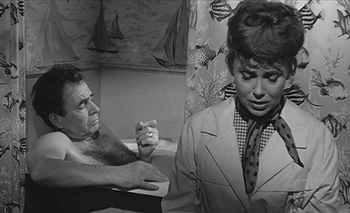 | 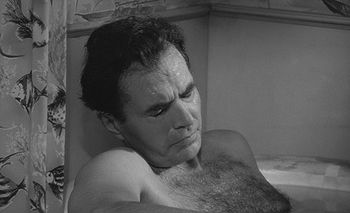 |
Shot 249 | Shot 250 |
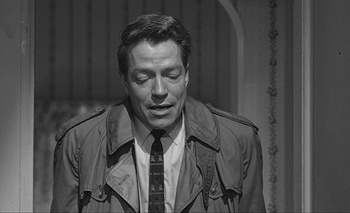 | 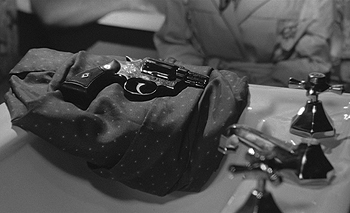 |
Shot 251 | Shot 252 |
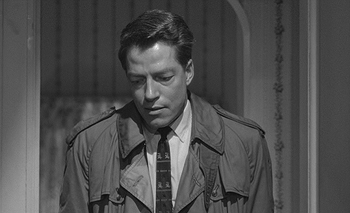 | 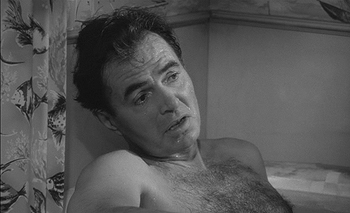 |
Shot 253 | Shot 254 |
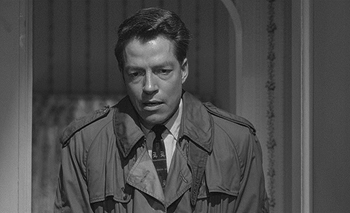 | 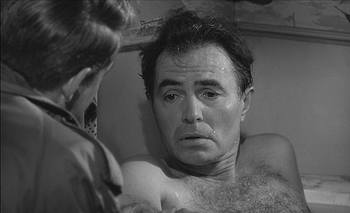 |
255 MS Humbert in the tub, from beyond the 4th wall, John kneeling beside the tub. (1:07:58)
JOHN: Perhaps you'd better tell him about Charlotte's kidney.
JEAN: Humbert, Charlotte didn't want anybody to know this, but...she hadn't long to...
256 MCU Humbert. (1:08:08)
JEAN (off screen): ....live anyhow.
JOHN: She only had one kidney.
JEAN (off screen): Yes...
JOHN: Born that way...
JEAN (off screen): That's right. And the one kidney she had was distressed.
JOHN: She had...
JEAN (off screen): Nephritis.
JOHN: Nephritis.
HUMBERT: Oh, Charlotte, oh...
The doorbell rings.
257 MS Humbert in the tub, from beyond the 4th wall. (1:08:23)
JOHN: I'll get it.
He rises and leaves.
JEAN: Humbert, try to think of your poor little...
258 MCU Humbert. (1:08:30)
JEAN (off screen): ...Lolita. All alone in the world. You must live for her sake.
259 LS John returns with Mr. Beale. (1:08:33)
FREDERICK BEALE SR.: Oh, excuse me.
HUMBERT: No, that's all right, come in please.
BEALE (sitting): I'm Frederick Beale, Sr.
HUMBERT: Oh.
BEALE: May I talk to you for a moment.
HUMBERT: Do, please.
BEALE: My son was driving the car.
HUMBERT: When...that thing happened.
BEALE: Yes. You know, my two youngest, Jack and Mary, are the same grade as your Lolita.
JEAN: He's had a terrible shock.
BEALE: Yes. Of course he has. You know this isn't easy to talk about but technically it was the pedestrian's fault...
260 MCU Humbert. (1:09:01)
BEALE (off screen): ...not the driver.
HUMBERT: Technically, you're absolutely right.
BEALE (off screen): It was raining and she ran across the road.
HUMBERT: You don't have to explain to me because I have no quarrel with you.
261 MCU Humbert from beyond the 4th wall, and Beale and John. (1:09:12)
BEALE: Well, I must say you're wonderfully sympathetic. In fact you've been so generous about the whole matter, I was about to suggest that maybe you'd allow me to pay the...
262 MCU Humbert. (1:09:23)
BEALE (off screen): ...funeral expenses.
HUMBERT: Oh...that's all right. Very nice of you. Thank you very much.
263 MCU Humbert from beyond the 4th wall, and Beale and John. (1:09:29)
BEALE: Well, that's the least I can do. It's my pleasure. Well, I won't keep you any longer. We'll have to get together very soon and sort out the..
264 MCU Humbert. (1:09:31)
BEALE (off screen): ...details.
HUMBERT: Yes, let's do. Yes.
Crossfade to shot 265.
Shot 255 | Shot 256 |
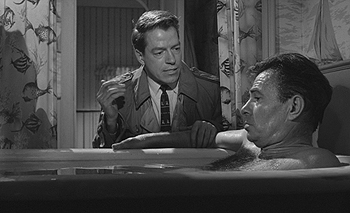 | 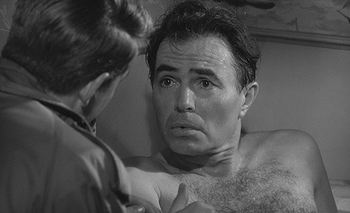 |
Shot 257 | Shot 258 |
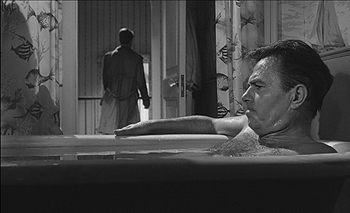 | 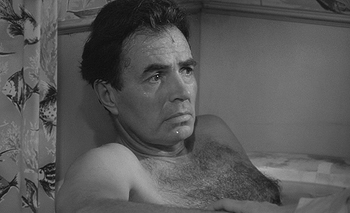 |
Shot 259 | Shot 260 |
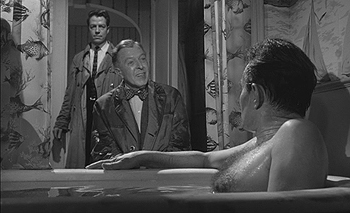 |  |
Shot 261 | Shot 262 |
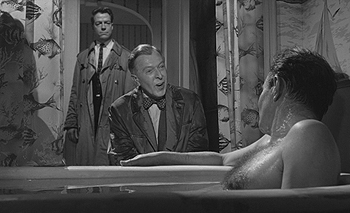 | 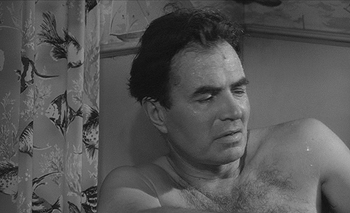 |
Shot 263 | Shot 264 |
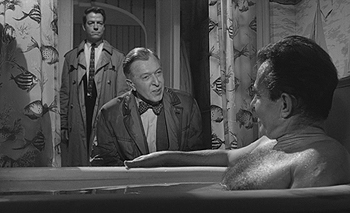 | 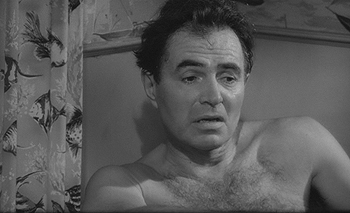 |
In the screenplay, there is no subsequent scene with Humbert in the tub, no Farlows consoling him and seeing the gun and thinking he plans to kill himself. No Beale Sr. offering to pay for the funeral expenses.
In the book, the Farlows and several doctors do then come to Humbert's rescue, though there is no long conversation with the couple while he's in the tub. Beale does eventually arrive for a conversation and offers to pay the funeral expenses.
The kidney is neither in the screenplay nor the book. It draws attention because Charlotte's single, distressed kidney is the exception in all these doubles perpetrated by Nabokov and Kubrick. The kidney has no double and Charlotte hadn't long to live because of it.
Maybe a weird coincidence but kidney is, etymologically, a combination of an Old English word for womb (or bowel) and egg, the egg being a reference to its shape. If we look back to the scene of Lolita feeding Humbert, having eaten all his bacon and most of his toast, she feeds him one of two eggs. It's kind of like Humbert had consumed one of Charlotte's kidneys.
Poor Charlotte.
Lolita fed Humbert the egg as a reward for promising never to divulge any of her secrets. In this scene, Jean is relinquishing to Humbert one of dead Charlotte's secrets, a thing Charlotte had wanted no one to know about.
Yeah, yeah, this is perhaps just coincidence but what a fun coincidence if it is just that.
In Lolita's bedroom, on her bedstand, when she had left for camp, was a sculpted wood goldfish. When Humbert went to answer the phone in the hall, learning that Charlotte had been struck, a large glass fish could be seen on the shelf beside the stairs. The bath is all fish and sailboats.
When Humbert pulls the shower curtain he fails to screen himself so Jean sits facing away from him and throughout the latter part of the conversation she is only a shadow on the other side of the curtain. This may remind of Room 237 and the enigmatic and terrifying woman partially veiled by the shower curtain. Here, however, it very much reminds of Vivian Darkbloom, Quilty's co-author (Nabokov), who stood with her back to Charlotte at the dance.
Beale Sr., whose son struck Charlotte (in the book one of his older sons strikes Charlotte, but he's in the car), and is in this scene trying to convince Humbert that his son isn't responsible, as he sits next to the back-turned shadow of Jean/John Farlow, represents twinning/mirroring in the book, and Kubrick has kept this here with Beale's mention of his twins in Lolita's class.
The Beales' father kills Charlotte Haze, and they are the first of no less than five sets of twins or twinned names in Lolita's class (the Beales, the Cowans, the Talbots, and the incestuous Mirandas), a microscopic vision of the doubling (H.H. and Quilty) and mirroring that occurs in the roomy interior of the entire book (including Ray's Foreward), where even cars have their twins; "the long hairy arm of coincidence" is said to have its unpredictable "twin limb"; Mrs. Haze is echoed by the widow Mrs. Hays; and obscure women of science mirror one another in spite of the almost 300 pages separating them (Blanche Schwarzmann: "White Blackman", and Melanie Weiss: "Black White";).
Double names, initials and phonetic effects prevail throughout Lolita, whether the twinning is literal (Humbert Humbert, Vanessa van Ness, Quilty's Duk Duk Ranch, and H.H.'s alternate pseudonyms of "Otto Ott," "Mesmer Mesmer" and "Lambert Lambert"); or alliterative (Clare Quilty, Gaston Godin, Harold Haze, Bill Brown, and Clarence [Choate] Clark); or trickily alphabetically (John Ray Jr: J.R., Jr.). The double consonants of the almost infinite succession of humorously alliterative place names and points of interest H.H. visits are thus thematically consistent (Pierre Point, Hobby House, Hazy Hills, Kumfy Kabins, Raspberry Room, Chestnut Court, and so forth). Numbers even adhere to the pattern; H.H. imagines Lolita's unborn child "dreaming already in her of becoming a big shot and retiring around 2020 A.D." The name of "Harold D. Doublename" represents a summary phrase, but the annotator's double initials are only a happy coincidence".
Source: The Annotated Lolita
Looking at names, if you consider Beale, it appears to come from bel, beautiful, and so you find in it an association with Annabel Leigh/Lee which contains bel. And Anna contains within it the mirroring/doubling that both Kubrick and Nabokov employ.
It seems significant that in this bathroom we have, beside Beale with his male and female twins, John/Jean Farlow and Jean/John Farlow. As I've pointed out, their given names are feminine and masculine versions of the same name, making them twins of a sort and fitting in with the male to female shifts at the beginning of the movie. It seems also significant that Jean, upon seeing Humbert in the tub, turns her back and stands beside John just as Vivian had turned her back to Charlotte throughout Charlotte's conversation with Quilty at the dance. She had become faceless, and Jean, in the bathroom, is a shadow beyond the curtain throughout the scene with Beale.
Here's where I want to get into Lilith mythology. For, we may have the story of Lolita in the film, a girl who is abused by her stepfather, but we also have Humbert's fascination with her as an expression of Lilith. In order to better begin to get a grip on Lolita as an expression of Lilith, in order not to deny her fictional humanity, I'd ask that we try to comprehend the entity as ideas rather than personalities or entities. For instance, in Lilith we have the twistings of the Hebrew letter Lamed, as of a turning staircase, also a spiralling serpent, and Lilith is expressed sometimes as part serpent, part female, which fits also with her being embodied as well in Leviathan (again, serpentine) mythology.
Humbert himself writes, in the novel:
Humbert was perfectly capable of intercourse with Eve, but it was Lilith he longed for.
Charlotte was as Eve. Lolita was as Lilith.
Let's return briefly and look at the opening scene in Quilty's mansion and the statue of the warrior with the woman clasped to him.
As I had noted in the first section, there are some differences between this statue in Quilty's mansion and a like depiction I found on eBay. The one on eBay had cloth wrapped around the woman. The one in Quilty's mansion, instead of having a sheet wrapped about her, seems instead to be serpentine. I have already discussed the relationship with Lamia serpent enchantresses, but also Apollo-Python and Daphne.

This serpent twined about the woman also resembles a representative of Lilith, such as Michelangelo's representation of Lilith as the serpent of the tree of knowledge (Daath/DOTh) below.
From The Sistine Chapel (Michelangelo: Selected Scholarship in English) by William Wallace:
...vigorous and aggressive in her actions; she is possibly two-tailed; and she is Adam's twin, not Eve's. Michelangelo was apparently familiar with the cabalistic legend that Lilith was created with Adam--either as a Siamese twin who had to be split from Adam (who was an androgyne) or as a reflection of half of the image of God (and thus a fraternal twin to Adam). In Michelangelo's rendition, Adam and Lilith are both blonds...while Eve, situated below them, is a brunette. Gone is the traditional similarity between Even and her female impersonator. In its place is the twinship of Adam and Lilith, substantiated by their faces being almost mirror images and their heads being on the same hierarchical level...Adam's face is set in profile and in shadow, traditional ways of designating the betrayer Judas: Adam's dark act has betrayed God and all mankind.
Medieval Jewish scholars speculated that prior to the Lord's discovery of Adam's transgression, the serpent had the power to speak as a human and to be mobile on feet. Only after the sin's discovery did the Lord alter the serpent's posture (and anatomy) by His utterance of a curse...Michelangelo increased Lilith's suggestion of lost human mobility through an ambiguity in drawing that allows her to be seen as having two tails. A transmuted left thigh is clearly the source for one branch of her magnificent iridescent yellow-green-orange tail, but her right thigh remains hidden, leaving unanswered whether it also metamorphoses into a tail or is joined to the first. The ambiguity is accentuated by a coil that projects outward similar to a right leg supported by the crotch of the tree, and that--when coupled visually with the first tail--mimics the action of a human straddling the tree. The action could, however, alternately be read as one long tail coiled around the tree and back on itself.
Sensitive to Lilith's associations with the night, Michelangelo has also placed her in a back view with a dramatic contraposto that is recognizable as the iconic pose in ancient art for the upper portion of Selene, Greek goddess of the moon and night.
Quilty's mansion has also a number of twisted columns in it.
Vivian Darkbloom, at the dance, is depicted as wearing a twisted serpentine bracelet about her upper arm, which connects back with this statue of the woman (Lilith) clasped to the man in the first section.
Backing up again to Michelangelo's representation of Lilith as the serpent winding up the tree in the midst of the garden, I had proposed that the statue of the woman clasped to the man is answered by (in essence, becomes) an opposite statue in the Greek Key circle, the one of the woman with the shoe on her head.
This statue, in the film, arises out of a tree in a crossfade.
Lolita is also found in the center of Charlotte's garden.
Lilith, the first wife of Adam, usually depicted as having become a demon, has ties with the storm (a storm goddess) as well as the sphinx. What I'm most interested in is her tie in with that which is serpentine as in twining, twisting, by which we have deja vu (and thus anamnesis) in her being partly representative of time and patterns of repetition, in the ascending spiral. We find this in Lolita with Humbert's Annabel Leigh being found again in Lolita--which takes us to the scene where Kubrick excised Nabokov's having shown Lolita a picture of Annabel Leigh and the audience seeing that Annabel Leigh is played by the same actress as Lolita (who is given as not recognizing the resemblance) and replaced it with the reading of the poem by Poe in which the protagonist seems doomed to repeat the past, coming upon it by surprise, led by some demon, Humbert discussing with Lolita the twists and turns in the poem by which we had mid returning as dim.
Kubrick uses this throughout his films, his characters caught in cycles, repetitions, led on by deja vu experiences, variations on a theme expressive of cycles (a maze of repetitions) that act as spirals rather than the circle of Neitzche's eternal return.
I cover much of this already in A Clockwork Orange, especially the Leviathan angle which I will briefly glance on below.
One of the many myths of Lilith, as expressed in Wikipedia, expresses how Humbert would pursue Lolita as she represents the Lilith that was originally part of Adam then dissociated from him. This fits with what I've written about Humbert projecting not simply Annabel but himself upon Lolita. She becomes a self-portrait of him, of sorts. I write of this in the third section of "Portrait of Lolita, an Analysis of the Shooting of the George Romney Painting, in which I discuss how the painting of Lolita's toenails relates to the films "Scarlet Street" and "La Chienne". La Chienne is a young prostitute who becomes involved with a painter who eventually kills her when he learns she doesn't love him. She is also him, for she adopts his words and passes off his paintings, with his permission, as having been done by her. In "Scarlet Street", a remake of this, when the painter does a portrait of the prostitute he thus calls it his self-portrait. So I wonder if we see Lolita in the curly little poodle that the car avoids hitting, striking Charlotte instead who had just learned about Humbert's loathing of her and his desire for Lolita.
"God originally created Adam and Lilith in a manner that the female creature was contained in the male. Lilith's soul was lodged in the depths of the Great Abyss. When God called her, she joined Adam...Adam was left lying as a body without a soul. Then a cloud descended and God commanded the earth to produce a living soul. This God breathed into Adam, who began to spring to life and his female was attached to his side. God separated the female from Adam's side. The female side was Lilith, whereupon she flew to the Cities of the Sea and attacks humankind. Yet another version claims that Lilith emerged as a divine entity that was born spontaneously, either out of the Great Supernal Abyss or out of the power of an aspect of God (the Gevurah of Din). This aspect of God, one of his ten attributes (Sefirot), at its lowest manifestation has an affinity with the realm of evil and it is out of this that Lilith merged with Samael. According to The Alphabet of Ben-Sira, Lilith was Adam's first wife."
A simple way of looking at Lilith is she represents lust. Desire. And Lolita is not only the focus of but represents Humbert's desire.
Again, from Wikipedia:
In answer to your question concerning Lilith, I shall explain to you the essence of the matter. Concerning this point there is a received tradition from the ancient Sages who made use of the Secret Knowledge of the Lesser Palaces, which is the manipulation of demons and a ladder by which one ascends to the prophetic levels. In this tradition it is made clear that Samael and Lilith were born as one, similar to the form of Adam and Eve who were also born as one, reflecting what is above. This is the account of Lilith which was received by the Sages in the Secret Knowledge of the Palaces.
We have here the twin androgynous couples of Samuel and Lilith, double-faced, hermaphroditic, corresponding to Adam and Eve.
Further. from Wikipedia.
The marriage of Samael and Lilith is known as the "Angel Satan" or the "Other God", but it was not allowed to last. To prevent Lilith and Samael's demonic children, Lilin, from filling the world, God castrated Samael. In many 17th century Kabbalistic books, this mythologem is based on the identification of "Leviathan the Slant [bariyach, fugitive] Serpent and Leviathan the Torturous [aqallathown, crooked, winding] Serpent [nacash, from the idea of hissing, as a snake, a hypnotizing enchanter]" and a reinterpretation of an old Talmudic myth where God castrated the male Leviathan and slew the female Leviathan in order to prevent them from mating and thereby destroying the earth.
Quilty, an alter ego of Humbert's, in the book is given as impotent.
As I said earlier, this isn't something to approach literally or to think of in terms of real entities. And to conceive of what has been described as Lilithian as demonic evil is to ignore that.
This all gets fairly elaborate and confounding to one unfamiliar with Jewish mysticism. I could give links to any number of expressions of Lilith and Leviathan mythologies used in art to illustrate how it's not way off the beam to look into the possibility of their use in Kubrick's films.
Nabokov's book, Look at the Harlequins!, has another Lolita-type character whose name is Dolly. Nabokov furnishes scarce description of her, but notes she has Lilithian eyes. Nabokov certainly had Lilith in mind.
In a 1962 interview with BBC television, asked about Lolita's inception, Nabokov responded:
She was born a long time ago, it must have been in 1939, in Paris; the first little throb of Lolita went through me in Paris in '39, or perhaps early in '40, at a time when I was laid up with a fierce attack of intercostal neuralgia which is a very painful complaint-- rather like the fabulous stitch in Adam's side.
Nabokov's description of Adam's rib, from which Lilith was created in some of the Lilithian legends, is given as related to neuralgia, but with the reference to Adam we seem to have also the true birth of Lolita, and another reference to Lolita as Lilith.
Now we move on to a Lolita without Shelly Winters. It must be done but it's difficult to leave Charlotte behind as Shelly was magnificent in the film.
November 2014 transferred to html. Originally posted sometime before 2012. Approx 15,200 words or 31 single-spaced pages. A 117 minute read at 130 wpm.
Go to Part 4
Go to Table of Contents of the analysis (and supplemental posts)
Link to the main TOC page for all the analyses